Implementation of IOT in Data Center Management: A Study
VerifiedAdded on 2021/01/02
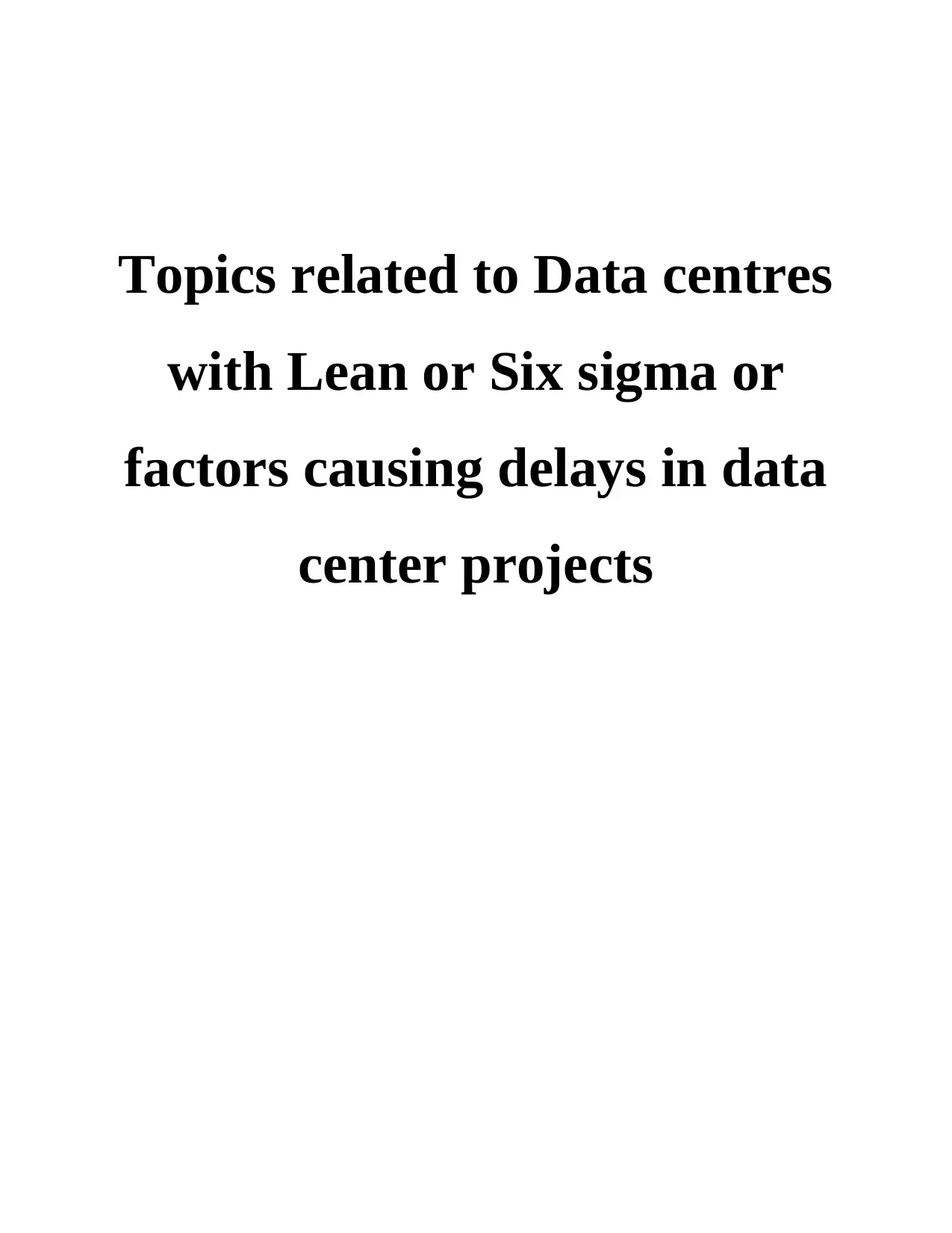
with Lean or Six sigma or
factors causing delays in data
center projects
Paraphrase This Document

Aim:
To implement Internet of things (IOT) in data centre management.
Summary:
The study discussed the concept of IOT and its role and impact on the performance and
management of data centre. It evaluates both positive and negative aspect of IOT for this
purpose.
Research method:
In this study primary data collection methods are used. To evaluate the findings statistical
analysis has been used in the study. This quantitative study uses positivism philosophy of
research and random sampling for the data collection. The research uses deductive approach.
Findings:
It has been analysed from the study that IOT has been very beneficial for the data centres
as it makes management process very convenient with increased efficiencies. However, the
privacy challenges need to be addressed.
Conclusion:
It can be concluded that in order to effectively incorporate benefits of IOT in business
data centre managers must evaluate the possible challenges of IOT so that such privacy risk can
be overcome.
Keywords:
In this study following keywords are used for the study purpose:
Data centre, Internet of things. Challenges and impact of IOT on data centre
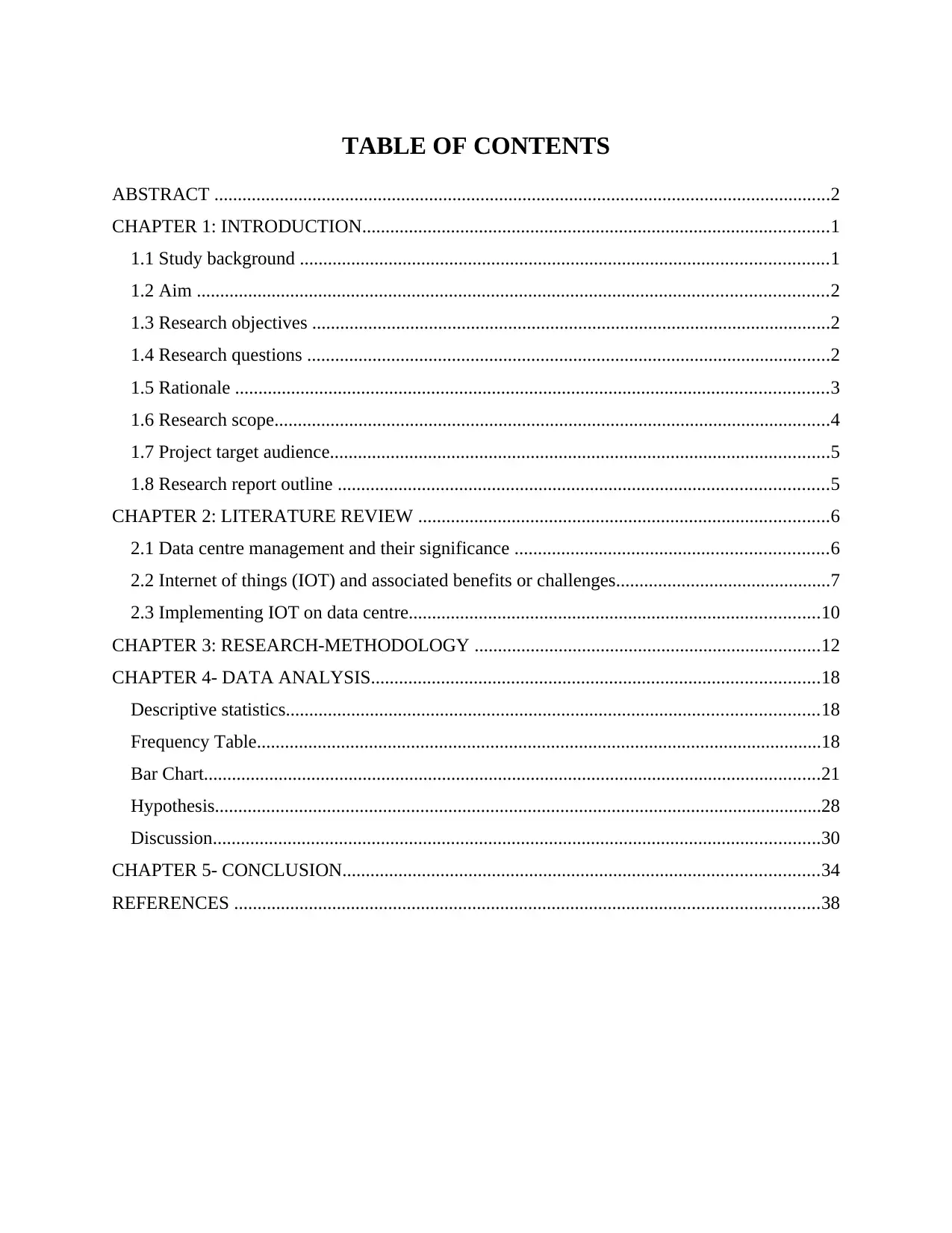
ABSTRACT ....................................................................................................................................2
CHAPTER 1: INTRODUCTION....................................................................................................1
1.1 Study background .................................................................................................................1
1.2 Aim .......................................................................................................................................2
1.3 Research objectives ...............................................................................................................2
1.4 Research questions ................................................................................................................2
1.5 Rationale ...............................................................................................................................3
1.6 Research scope.......................................................................................................................4
1.7 Project target audience...........................................................................................................5
1.8 Research report outline .........................................................................................................5
CHAPTER 2: LITERATURE REVIEW ........................................................................................6
2.1 Data centre management and their significance ...................................................................6
2.2 Internet of things (IOT) and associated benefits or challenges..............................................7
2.3 Implementing IOT on data centre........................................................................................10
CHAPTER 3: RESEARCH-METHODOLOGY ..........................................................................12
CHAPTER 4- DATA ANALYSIS................................................................................................18
Descriptive statistics..................................................................................................................18
Frequency Table.........................................................................................................................18
Bar Chart....................................................................................................................................21
Hypothesis..................................................................................................................................28
Discussion..................................................................................................................................30
CHAPTER 5- CONCLUSION......................................................................................................34
REFERENCES .............................................................................................................................38
⊘ This is a preview!⊘
Do you want full access?
Subscribe today to unlock all pages.

Trusted by 1+ million students worldwide

Title: “Implementation of Internet of things (IOT) in data centre management”
1.1 Study background
Data centre is defined as the interconnected network of computer servers which is used
for storing, processing and managing organisational data. Data centre management (DCM) refers
to the management process within a data centre so that IT and other related technical issues can
be resolved. To overcome the functional errors and barriers DCM operations manages and
regulate the server and computers functions, amount of data flow, applications and the security
considerations of the data (Ben-Daya, Hassini and Bahroun, 2017). Along with the management
of data set DCM also upgrade the systems and software and conducts the backup processes,
technical assistance and emergency planning for the protection and accurate data handling.
However, DCM suffers from several difficulties and performance issues (Aazam and Huh,
2015). For instance, since these systems consist of various operating systems and equipment data
centre managers are required to maintain multiple number of vendors, contractors, upgrade
processes and licenses.
1
Illustration 1: Internet of things
Paraphrase This Document
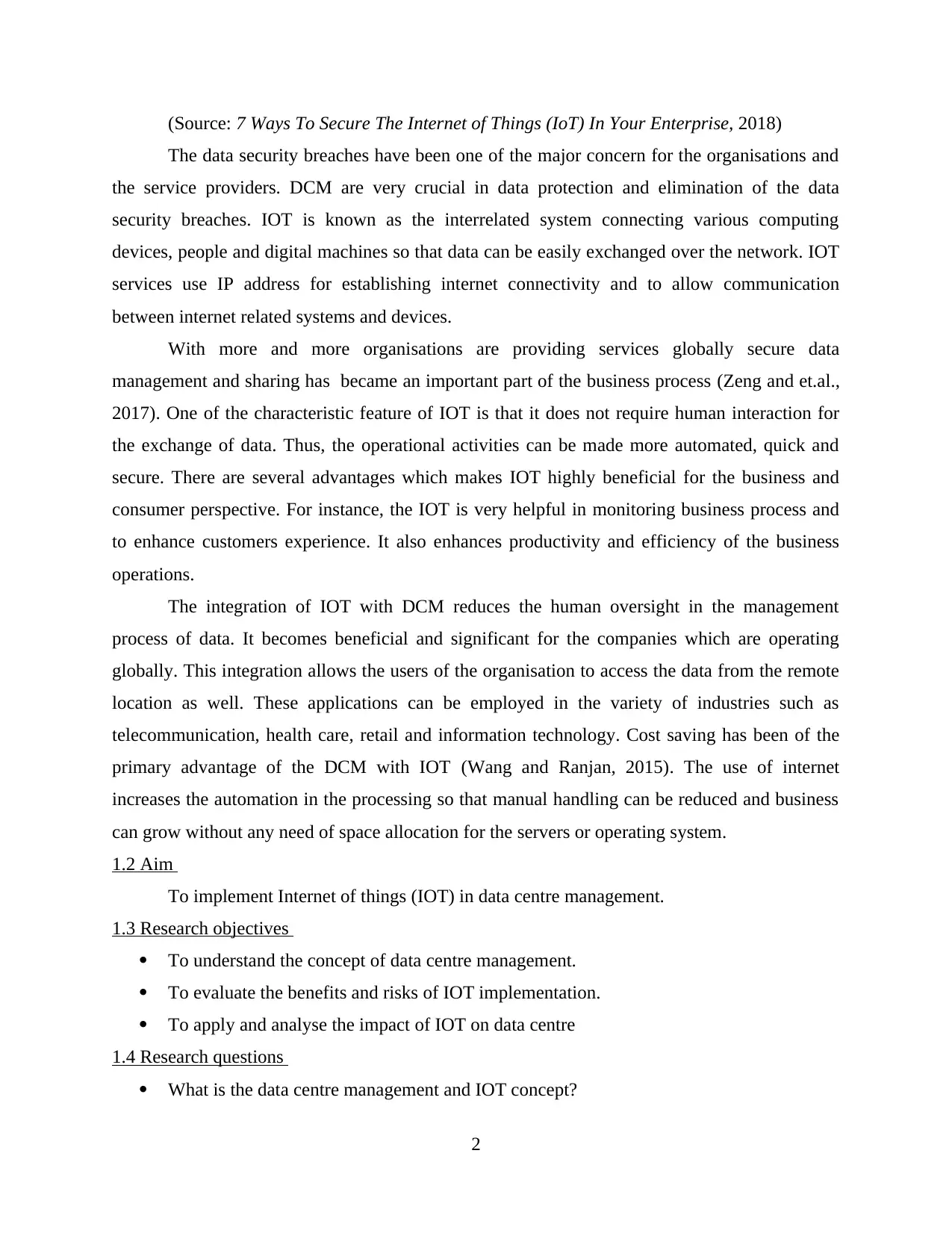
The data security breaches have been one of the major concern for the organisations and
the service providers. DCM are very crucial in data protection and elimination of the data
security breaches. IOT is known as the interrelated system connecting various computing
devices, people and digital machines so that data can be easily exchanged over the network. IOT
services use IP address for establishing internet connectivity and to allow communication
between internet related systems and devices.
With more and more organisations are providing services globally secure data
management and sharing has became an important part of the business process (Zeng and et.al.,
2017). One of the characteristic feature of IOT is that it does not require human interaction for
the exchange of data. Thus, the operational activities can be made more automated, quick and
secure. There are several advantages which makes IOT highly beneficial for the business and
consumer perspective. For instance, the IOT is very helpful in monitoring business process and
to enhance customers experience. It also enhances productivity and efficiency of the business
operations.
The integration of IOT with DCM reduces the human oversight in the management
process of data. It becomes beneficial and significant for the companies which are operating
globally. This integration allows the users of the organisation to access the data from the remote
location as well. These applications can be employed in the variety of industries such as
telecommunication, health care, retail and information technology. Cost saving has been of the
primary advantage of the DCM with IOT (Wang and Ranjan, 2015). The use of internet
increases the automation in the processing so that manual handling can be reduced and business
can grow without any need of space allocation for the servers or operating system.
1.2 Aim
To implement Internet of things (IOT) in data centre management.
1.3 Research objectives
To understand the concept of data centre management.
To evaluate the benefits and risks of IOT implementation.
To apply and analyse the impact of IOT on data centre
1.4 Research questions
What is the data centre management and IOT concept?
2
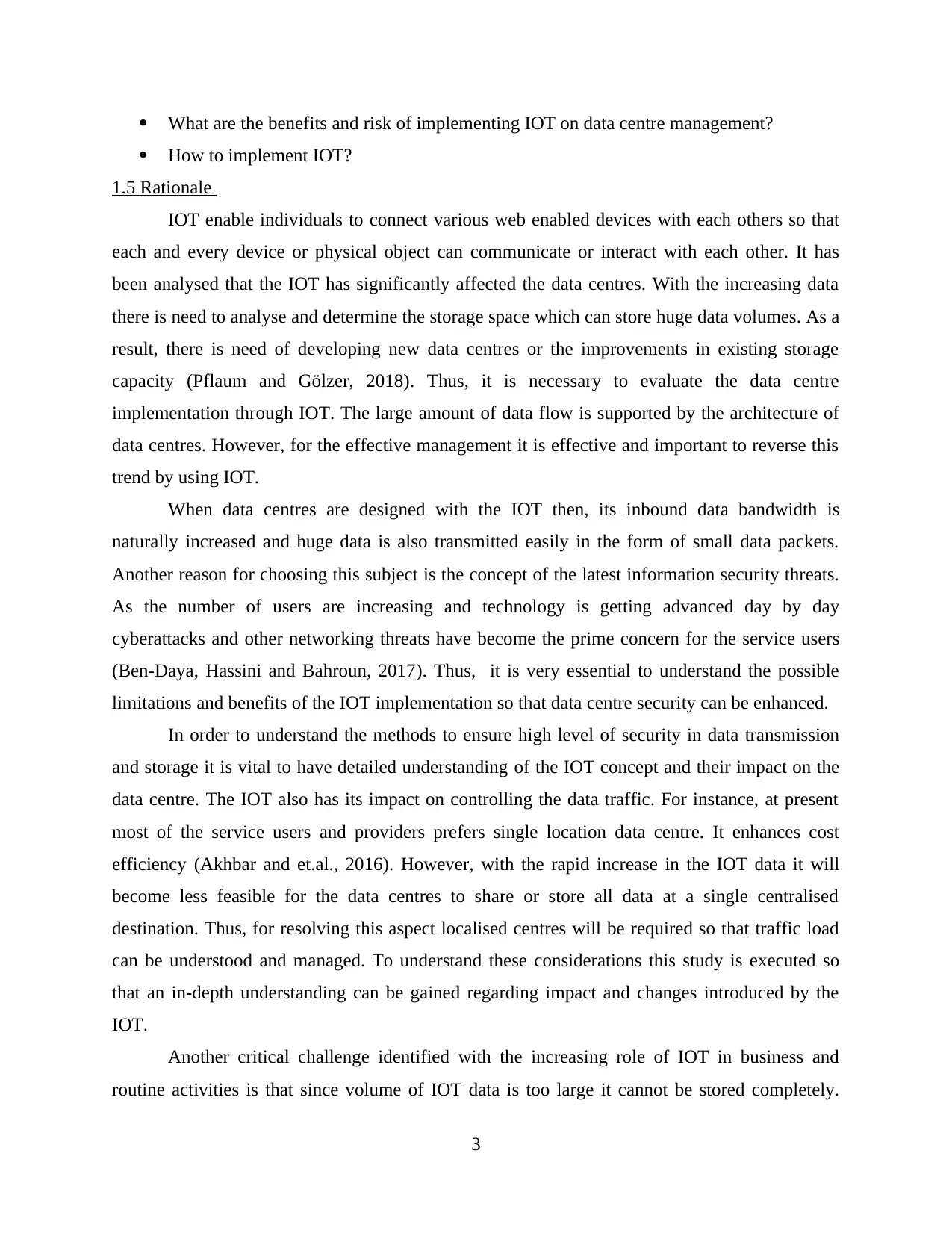
How to implement IOT?
1.5 Rationale
IOT enable individuals to connect various web enabled devices with each others so that
each and every device or physical object can communicate or interact with each other. It has
been analysed that the IOT has significantly affected the data centres. With the increasing data
there is need to analyse and determine the storage space which can store huge data volumes. As a
result, there is need of developing new data centres or the improvements in existing storage
capacity (Pflaum and Gölzer, 2018). Thus, it is necessary to evaluate the data centre
implementation through IOT. The large amount of data flow is supported by the architecture of
data centres. However, for the effective management it is effective and important to reverse this
trend by using IOT.
When data centres are designed with the IOT then, its inbound data bandwidth is
naturally increased and huge data is also transmitted easily in the form of small data packets.
Another reason for choosing this subject is the concept of the latest information security threats.
As the number of users are increasing and technology is getting advanced day by day
cyberattacks and other networking threats have become the prime concern for the service users
(Ben-Daya, Hassini and Bahroun, 2017). Thus, it is very essential to understand the possible
limitations and benefits of the IOT implementation so that data centre security can be enhanced.
In order to understand the methods to ensure high level of security in data transmission
and storage it is vital to have detailed understanding of the IOT concept and their impact on the
data centre. The IOT also has its impact on controlling the data traffic. For instance, at present
most of the service users and providers prefers single location data centre. It enhances cost
efficiency (Akhbar and et.al., 2016). However, with the rapid increase in the IOT data it will
become less feasible for the data centres to share or store all data at a single centralised
destination. Thus, for resolving this aspect localised centres will be required so that traffic load
can be understood and managed. To understand these considerations this study is executed so
that an in-depth understanding can be gained regarding impact and changes introduced by the
IOT.
Another critical challenge identified with the increasing role of IOT in business and
routine activities is that since volume of IOT data is too large it cannot be stored completely.
3
⊘ This is a preview!⊘
Do you want full access?
Subscribe today to unlock all pages.

Trusted by 1+ million students worldwide
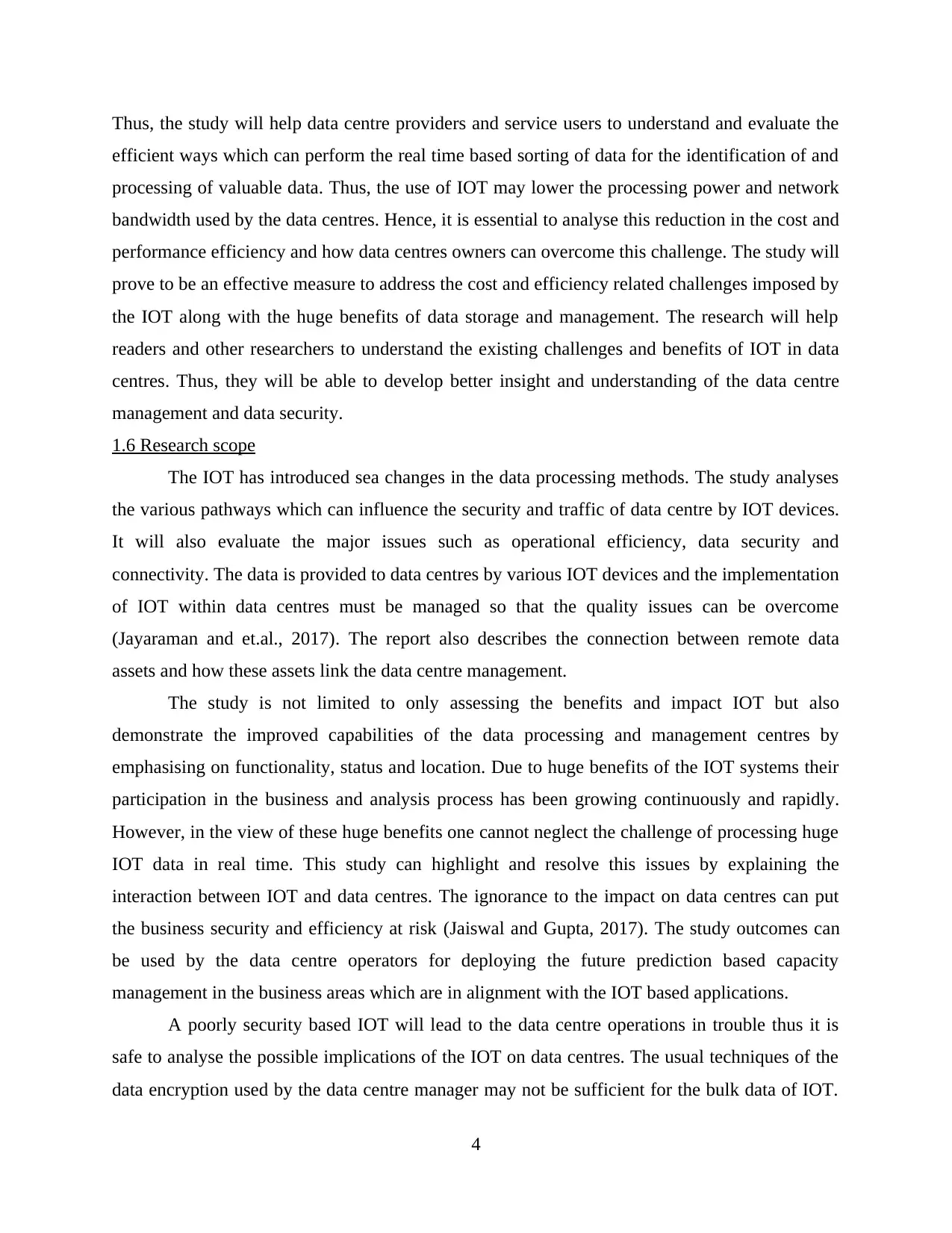
efficient ways which can perform the real time based sorting of data for the identification of and
processing of valuable data. Thus, the use of IOT may lower the processing power and network
bandwidth used by the data centres. Hence, it is essential to analyse this reduction in the cost and
performance efficiency and how data centres owners can overcome this challenge. The study will
prove to be an effective measure to address the cost and efficiency related challenges imposed by
the IOT along with the huge benefits of data storage and management. The research will help
readers and other researchers to understand the existing challenges and benefits of IOT in data
centres. Thus, they will be able to develop better insight and understanding of the data centre
management and data security.
1.6 Research scope
The IOT has introduced sea changes in the data processing methods. The study analyses
the various pathways which can influence the security and traffic of data centre by IOT devices.
It will also evaluate the major issues such as operational efficiency, data security and
connectivity. The data is provided to data centres by various IOT devices and the implementation
of IOT within data centres must be managed so that the quality issues can be overcome
(Jayaraman and et.al., 2017). The report also describes the connection between remote data
assets and how these assets link the data centre management.
The study is not limited to only assessing the benefits and impact IOT but also
demonstrate the improved capabilities of the data processing and management centres by
emphasising on functionality, status and location. Due to huge benefits of the IOT systems their
participation in the business and analysis process has been growing continuously and rapidly.
However, in the view of these huge benefits one cannot neglect the challenge of processing huge
IOT data in real time. This study can highlight and resolve this issues by explaining the
interaction between IOT and data centres. The ignorance to the impact on data centres can put
the business security and efficiency at risk (Jaiswal and Gupta, 2017). The study outcomes can
be used by the data centre operators for deploying the future prediction based capacity
management in the business areas which are in alignment with the IOT based applications.
A poorly security based IOT will lead to the data centre operations in trouble thus it is
safe to analyse the possible implications of the IOT on data centres. The usual techniques of the
data encryption used by the data centre manager may not be sufficient for the bulk data of IOT.
4
Paraphrase This Document
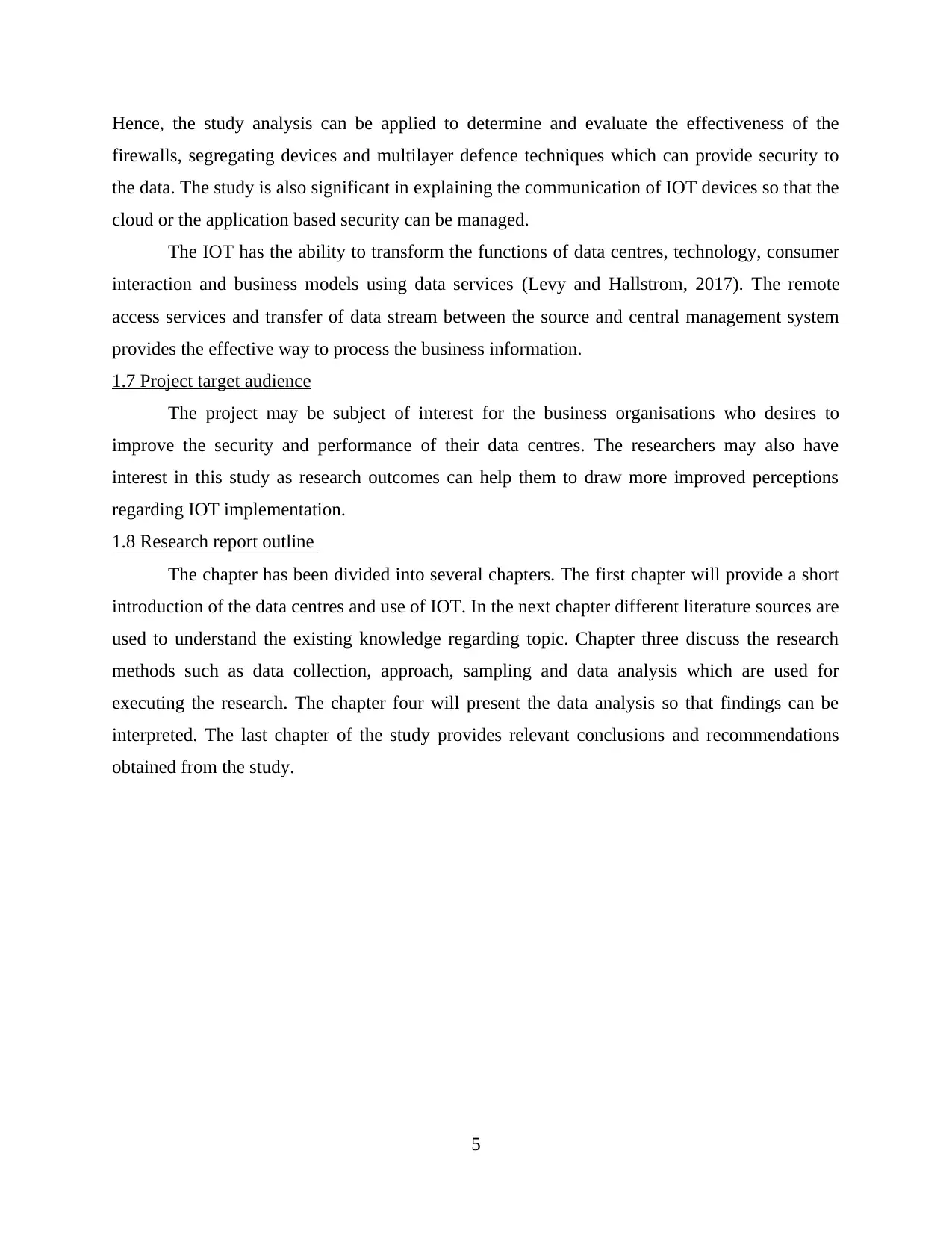
firewalls, segregating devices and multilayer defence techniques which can provide security to
the data. The study is also significant in explaining the communication of IOT devices so that the
cloud or the application based security can be managed.
The IOT has the ability to transform the functions of data centres, technology, consumer
interaction and business models using data services (Levy and Hallstrom, 2017). The remote
access services and transfer of data stream between the source and central management system
provides the effective way to process the business information.
1.7 Project target audience
The project may be subject of interest for the business organisations who desires to
improve the security and performance of their data centres. The researchers may also have
interest in this study as research outcomes can help them to draw more improved perceptions
regarding IOT implementation.
1.8 Research report outline
The chapter has been divided into several chapters. The first chapter will provide a short
introduction of the data centres and use of IOT. In the next chapter different literature sources are
used to understand the existing knowledge regarding topic. Chapter three discuss the research
methods such as data collection, approach, sampling and data analysis which are used for
executing the research. The chapter four will present the data analysis so that findings can be
interpreted. The last chapter of the study provides relevant conclusions and recommendations
obtained from the study.
5
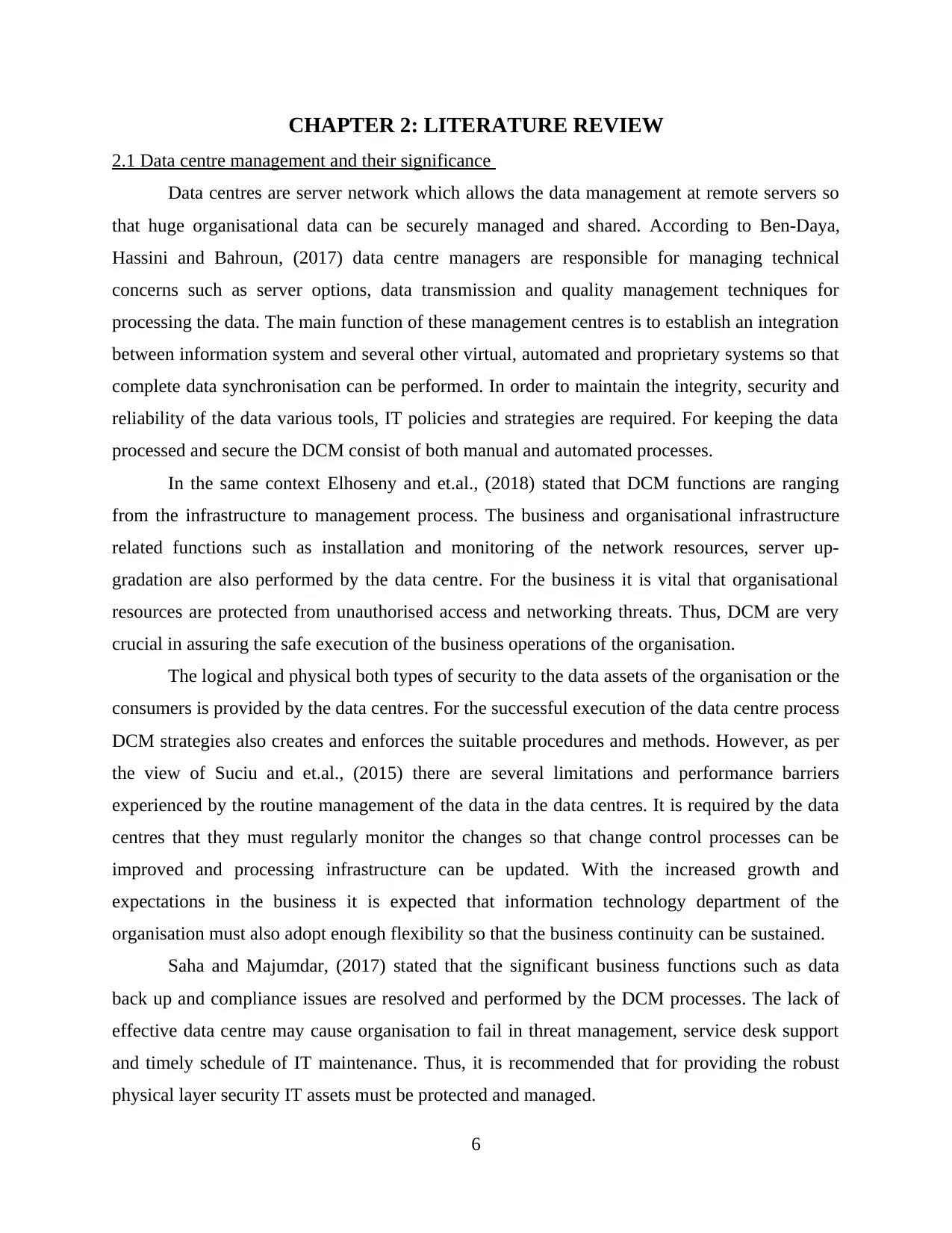
2.1 Data centre management and their significance
Data centres are server network which allows the data management at remote servers so
that huge organisational data can be securely managed and shared. According to Ben-Daya,
Hassini and Bahroun, (2017) data centre managers are responsible for managing technical
concerns such as server options, data transmission and quality management techniques for
processing the data. The main function of these management centres is to establish an integration
between information system and several other virtual, automated and proprietary systems so that
complete data synchronisation can be performed. In order to maintain the integrity, security and
reliability of the data various tools, IT policies and strategies are required. For keeping the data
processed and secure the DCM consist of both manual and automated processes.
In the same context Elhoseny and et.al., (2018) stated that DCM functions are ranging
from the infrastructure to management process. The business and organisational infrastructure
related functions such as installation and monitoring of the network resources, server up-
gradation are also performed by the data centre. For the business it is vital that organisational
resources are protected from unauthorised access and networking threats. Thus, DCM are very
crucial in assuring the safe execution of the business operations of the organisation.
The logical and physical both types of security to the data assets of the organisation or the
consumers is provided by the data centres. For the successful execution of the data centre process
DCM strategies also creates and enforces the suitable procedures and methods. However, as per
the view of Suciu and et.al., (2015) there are several limitations and performance barriers
experienced by the routine management of the data in the data centres. It is required by the data
centres that they must regularly monitor the changes so that change control processes can be
improved and processing infrastructure can be updated. With the increased growth and
expectations in the business it is expected that information technology department of the
organisation must also adopt enough flexibility so that the business continuity can be sustained.
Saha and Majumdar, (2017) stated that the significant business functions such as data
back up and compliance issues are resolved and performed by the DCM processes. The lack of
effective data centre may cause organisation to fail in threat management, service desk support
and timely schedule of IT maintenance. Thus, it is recommended that for providing the robust
physical layer security IT assets must be protected and managed.
6
⊘ This is a preview!⊘
Do you want full access?
Subscribe today to unlock all pages.

Trusted by 1+ million students worldwide
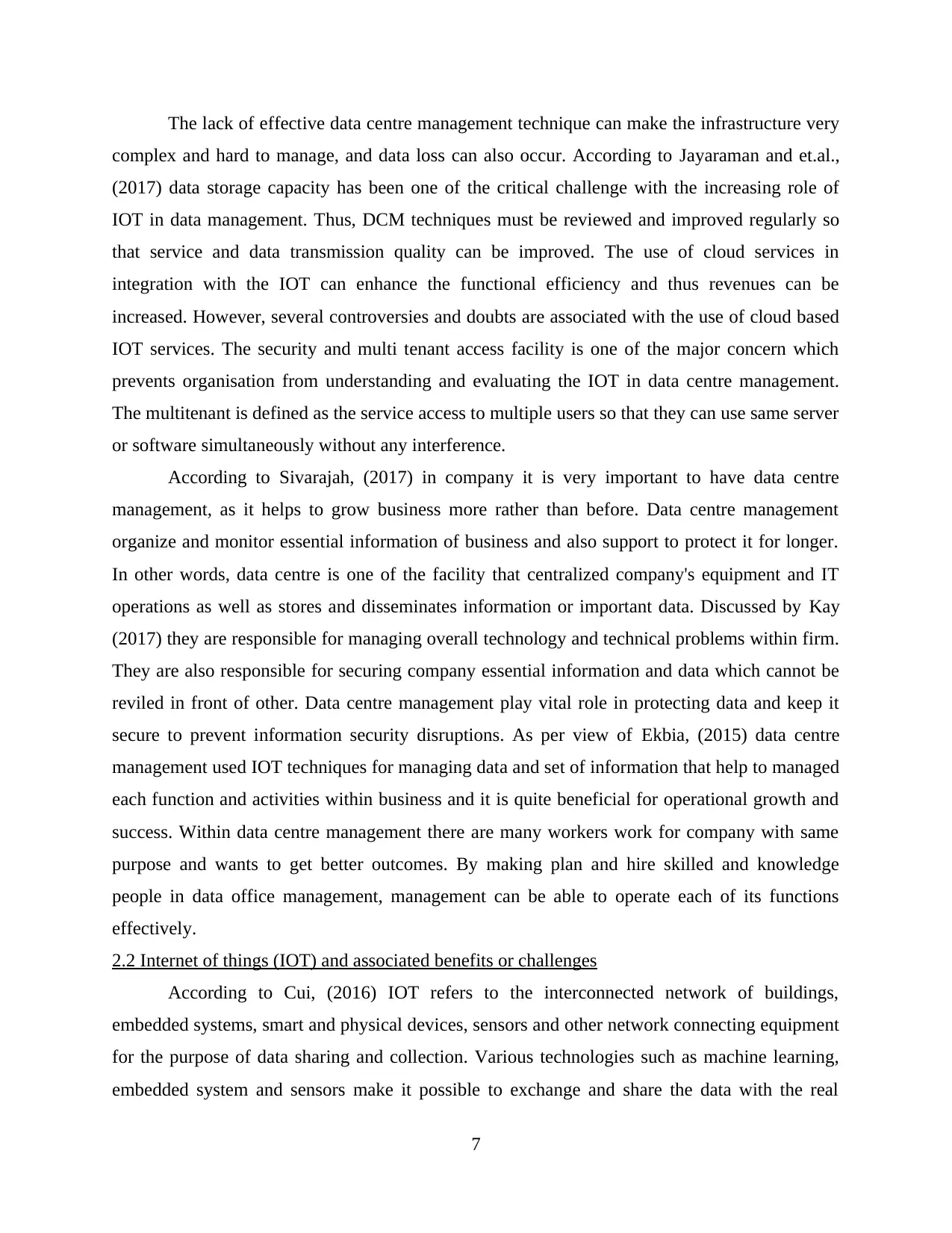
complex and hard to manage, and data loss can also occur. According to Jayaraman and et.al.,
(2017) data storage capacity has been one of the critical challenge with the increasing role of
IOT in data management. Thus, DCM techniques must be reviewed and improved regularly so
that service and data transmission quality can be improved. The use of cloud services in
integration with the IOT can enhance the functional efficiency and thus revenues can be
increased. However, several controversies and doubts are associated with the use of cloud based
IOT services. The security and multi tenant access facility is one of the major concern which
prevents organisation from understanding and evaluating the IOT in data centre management.
The multitenant is defined as the service access to multiple users so that they can use same server
or software simultaneously without any interference.
According to Sivarajah, (2017) in company it is very important to have data centre
management, as it helps to grow business more rather than before. Data centre management
organize and monitor essential information of business and also support to protect it for longer.
In other words, data centre is one of the facility that centralized company's equipment and IT
operations as well as stores and disseminates information or important data. Discussed by Kay
(2017) they are responsible for managing overall technology and technical problems within firm.
They are also responsible for securing company essential information and data which cannot be
reviled in front of other. Data centre management play vital role in protecting data and keep it
secure to prevent information security disruptions. As per view of Ekbia, (2015) data centre
management used IOT techniques for managing data and set of information that help to managed
each function and activities within business and it is quite beneficial for operational growth and
success. Within data centre management there are many workers work for company with same
purpose and wants to get better outcomes. By making plan and hire skilled and knowledge
people in data office management, management can be able to operate each of its functions
effectively.
2.2 Internet of things (IOT) and associated benefits or challenges
According to Cui, (2016) IOT refers to the interconnected network of buildings,
embedded systems, smart and physical devices, sensors and other network connecting equipment
for the purpose of data sharing and collection. Various technologies such as machine learning,
embedded system and sensors make it possible to exchange and share the data with the real
7
Paraphrase This Document
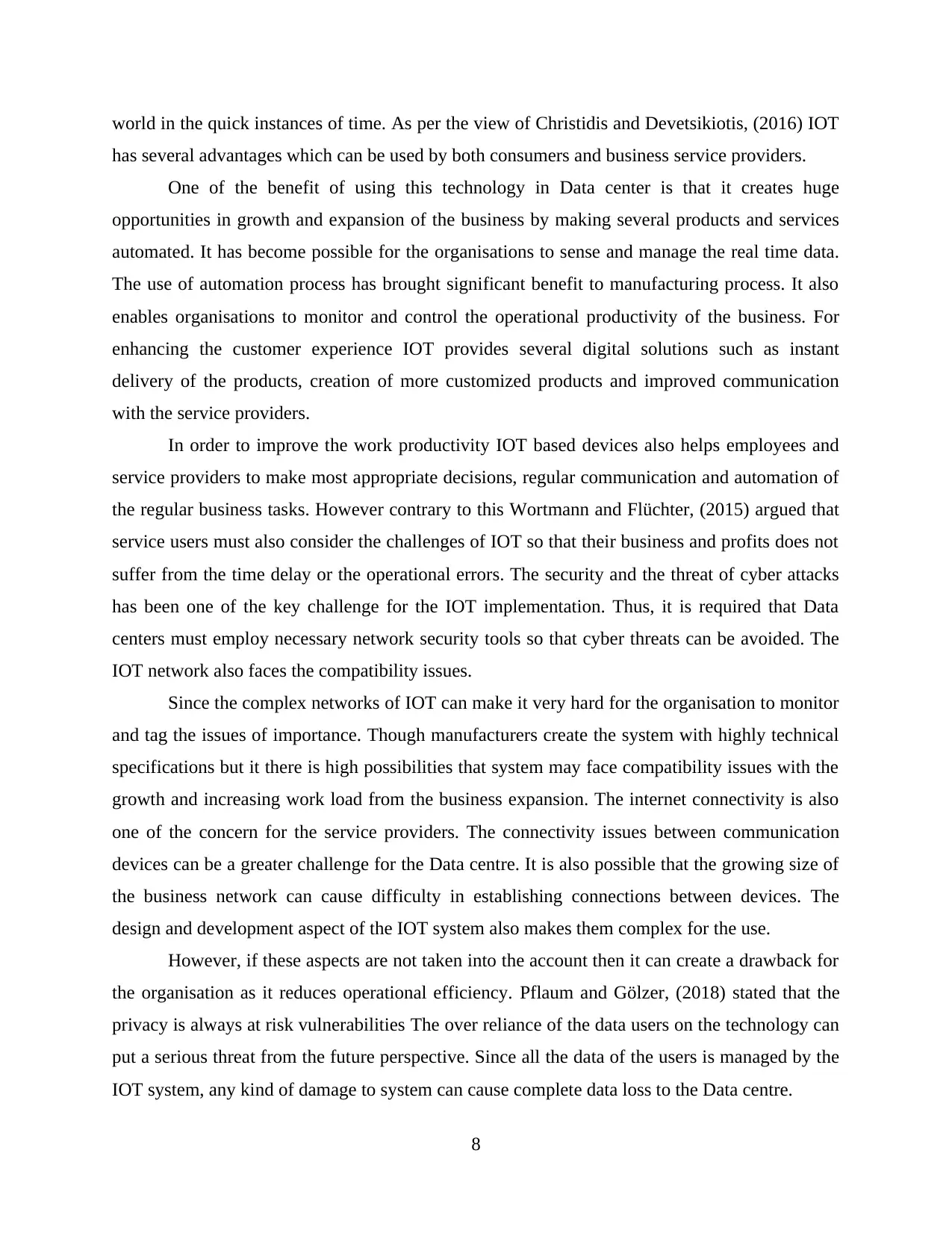
has several advantages which can be used by both consumers and business service providers.
One of the benefit of using this technology in Data center is that it creates huge
opportunities in growth and expansion of the business by making several products and services
automated. It has become possible for the organisations to sense and manage the real time data.
The use of automation process has brought significant benefit to manufacturing process. It also
enables organisations to monitor and control the operational productivity of the business. For
enhancing the customer experience IOT provides several digital solutions such as instant
delivery of the products, creation of more customized products and improved communication
with the service providers.
In order to improve the work productivity IOT based devices also helps employees and
service providers to make most appropriate decisions, regular communication and automation of
the regular business tasks. However contrary to this Wortmann and Flüchter, (2015) argued that
service users must also consider the challenges of IOT so that their business and profits does not
suffer from the time delay or the operational errors. The security and the threat of cyber attacks
has been one of the key challenge for the IOT implementation. Thus, it is required that Data
centers must employ necessary network security tools so that cyber threats can be avoided. The
IOT network also faces the compatibility issues.
Since the complex networks of IOT can make it very hard for the organisation to monitor
and tag the issues of importance. Though manufacturers create the system with highly technical
specifications but it there is high possibilities that system may face compatibility issues with the
growth and increasing work load from the business expansion. The internet connectivity is also
one of the concern for the service providers. The connectivity issues between communication
devices can be a greater challenge for the Data centre. It is also possible that the growing size of
the business network can cause difficulty in establishing connections between devices. The
design and development aspect of the IOT system also makes them complex for the use.
However, if these aspects are not taken into the account then it can create a drawback for
the organisation as it reduces operational efficiency. Pflaum and Gölzer, (2018) stated that the
privacy is always at risk vulnerabilities The over reliance of the data users on the technology can
put a serious threat from the future perspective. Since all the data of the users is managed by the
IOT system, any kind of damage to system can cause complete data loss to the Data centre.
8
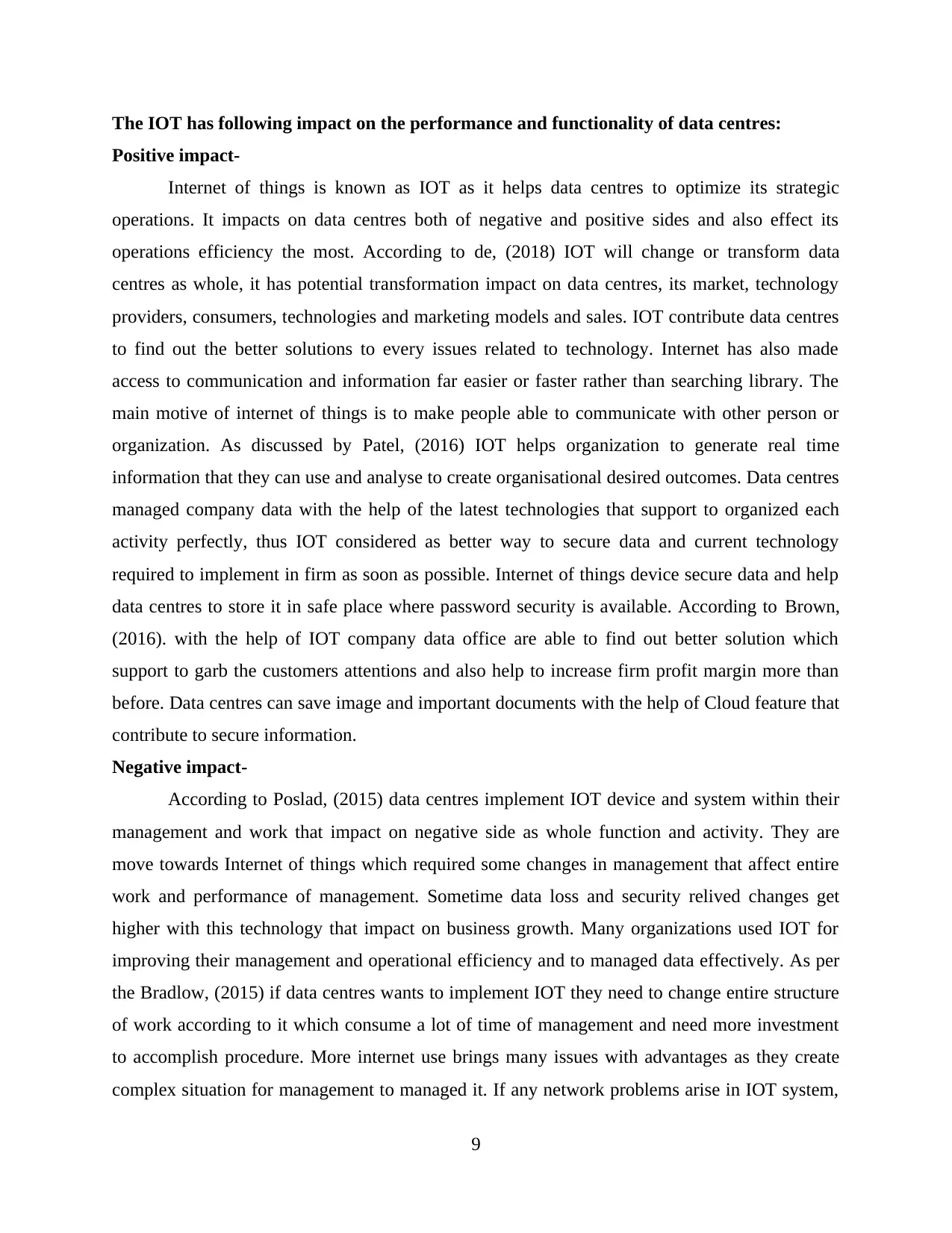
Positive impact-
Internet of things is known as IOT as it helps data centres to optimize its strategic
operations. It impacts on data centres both of negative and positive sides and also effect its
operations efficiency the most. According to de, (2018) IOT will change or transform data
centres as whole, it has potential transformation impact on data centres, its market, technology
providers, consumers, technologies and marketing models and sales. IOT contribute data centres
to find out the better solutions to every issues related to technology. Internet has also made
access to communication and information far easier or faster rather than searching library. The
main motive of internet of things is to make people able to communicate with other person or
organization. As discussed by Patel, (2016) IOT helps organization to generate real time
information that they can use and analyse to create organisational desired outcomes. Data centres
managed company data with the help of the latest technologies that support to organized each
activity perfectly, thus IOT considered as better way to secure data and current technology
required to implement in firm as soon as possible. Internet of things device secure data and help
data centres to store it in safe place where password security is available. According to Brown,
(2016). with the help of IOT company data office are able to find out better solution which
support to garb the customers attentions and also help to increase firm profit margin more than
before. Data centres can save image and important documents with the help of Cloud feature that
contribute to secure information.
Negative impact-
According to Poslad, (2015) data centres implement IOT device and system within their
management and work that impact on negative side as whole function and activity. They are
move towards Internet of things which required some changes in management that affect entire
work and performance of management. Sometime data loss and security relived changes get
higher with this technology that impact on business growth. Many organizations used IOT for
improving their management and operational efficiency and to managed data effectively. As per
the Bradlow, (2015) if data centres wants to implement IOT they need to change entire structure
of work according to it which consume a lot of time of management and need more investment
to accomplish procedure. More internet use brings many issues with advantages as they create
complex situation for management to managed it. If any network problems arise in IOT system,
9
⊘ This is a preview!⊘
Do you want full access?
Subscribe today to unlock all pages.

Trusted by 1+ million students worldwide
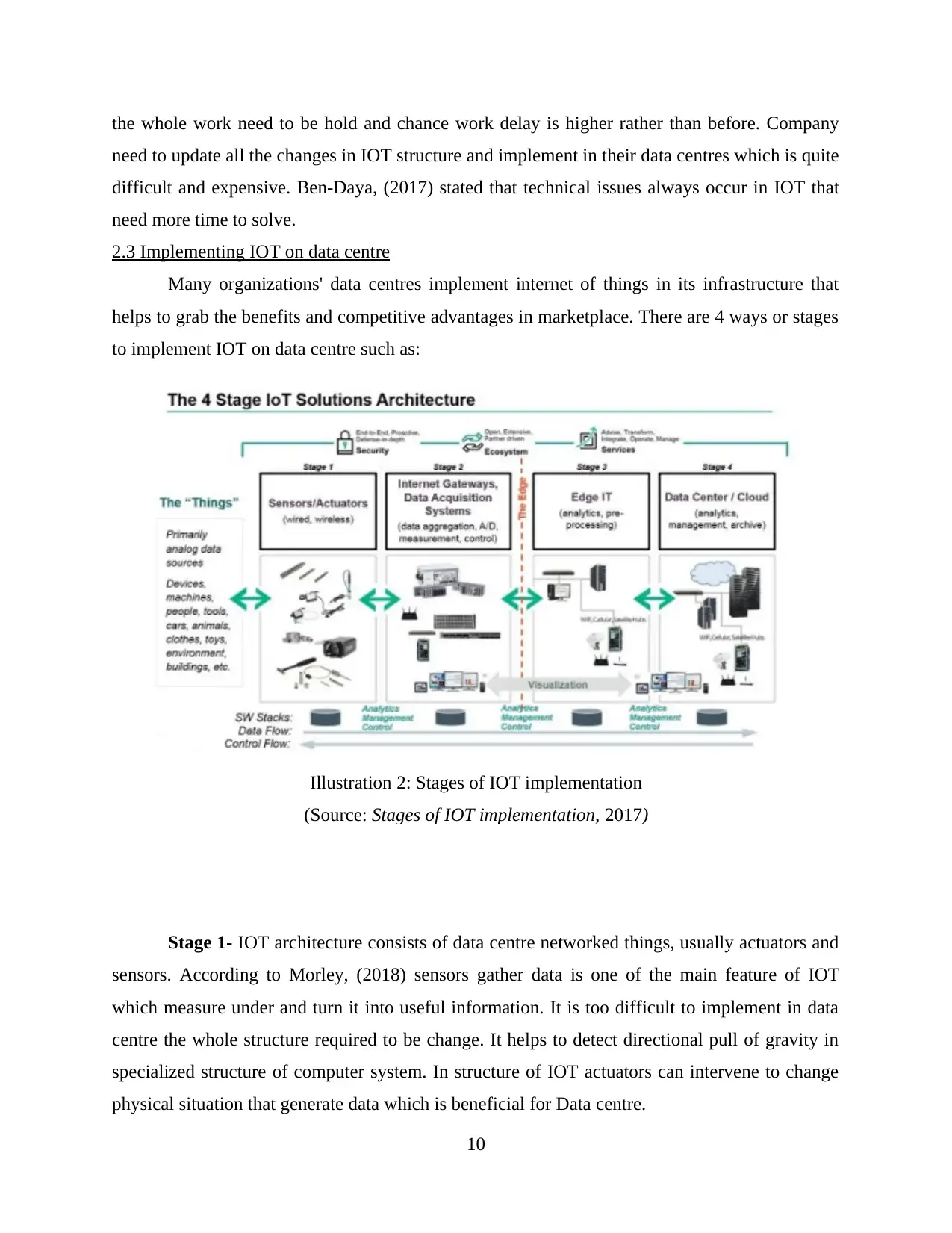
need to update all the changes in IOT structure and implement in their data centres which is quite
difficult and expensive. Ben-Daya, (2017) stated that technical issues always occur in IOT that
need more time to solve.
2.3 Implementing IOT on data centre
Many organizations' data centres implement internet of things in its infrastructure that
helps to grab the benefits and competitive advantages in marketplace. There are 4 ways or stages
to implement IOT on data centre such as:
Stage 1- IOT architecture consists of data centre networked things, usually actuators and
sensors. According to Morley, (2018) sensors gather data is one of the main feature of IOT
which measure under and turn it into useful information. It is too difficult to implement in data
centre the whole structure required to be change. It helps to detect directional pull of gravity in
specialized structure of computer system. In structure of IOT actuators can intervene to change
physical situation that generate data which is beneficial for Data centre.
10
Illustration 2: Stages of IOT implementation
(Source: Stages of IOT implementation, 2017)
Paraphrase This Document
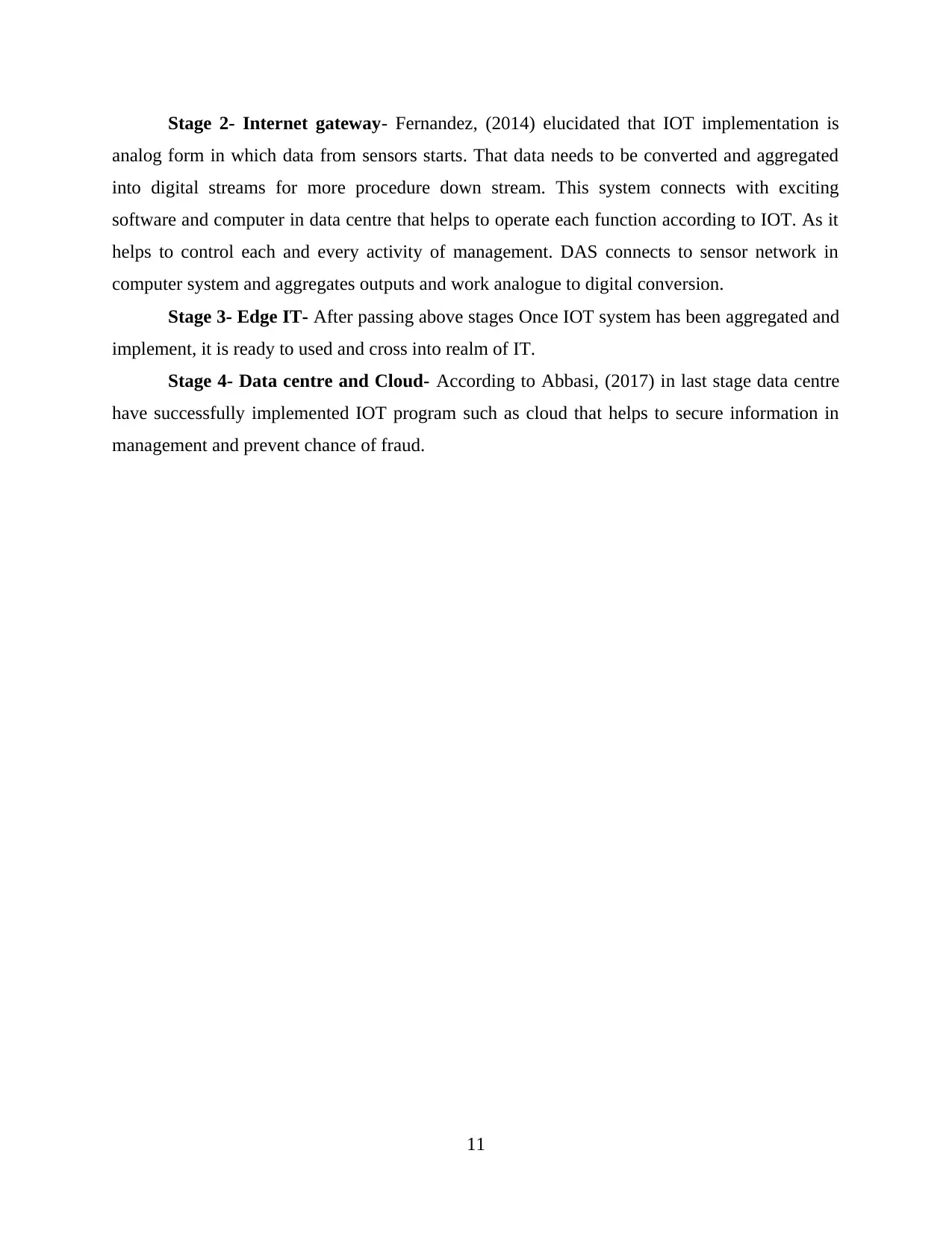
analog form in which data from sensors starts. That data needs to be converted and aggregated
into digital streams for more procedure down stream. This system connects with exciting
software and computer in data centre that helps to operate each function according to IOT. As it
helps to control each and every activity of management. DAS connects to sensor network in
computer system and aggregates outputs and work analogue to digital conversion.
Stage 3- Edge IT- After passing above stages Once IOT system has been aggregated and
implement, it is ready to used and cross into realm of IT.
Stage 4- Data centre and Cloud- According to Abbasi, (2017) in last stage data centre
have successfully implemented IOT program such as cloud that helps to secure information in
management and prevent chance of fraud.
11
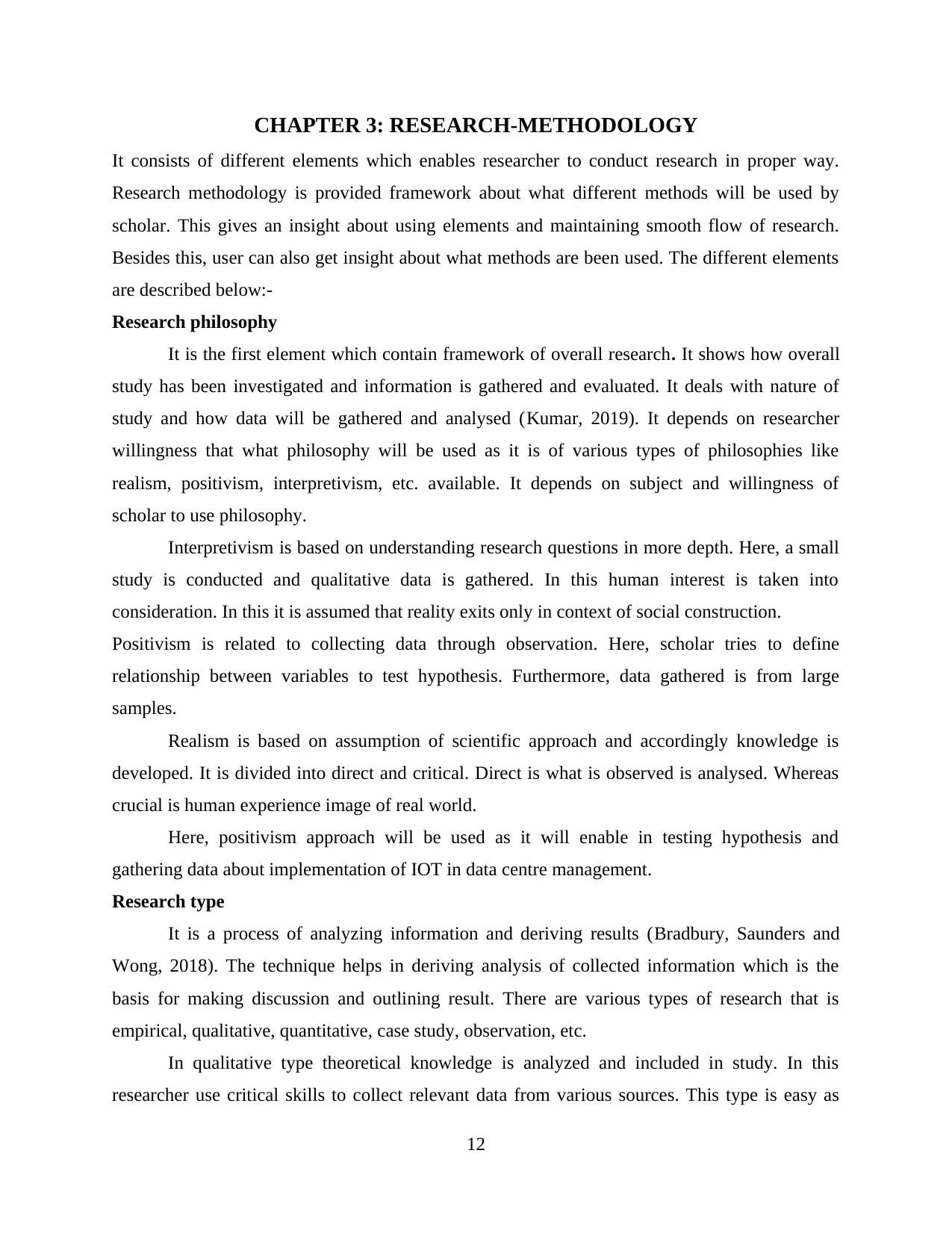
It consists of different elements which enables researcher to conduct research in proper way.
Research methodology is provided framework about what different methods will be used by
scholar. This gives an insight about using elements and maintaining smooth flow of research.
Besides this, user can also get insight about what methods are been used. The different elements
are described below:-
Research philosophy
It is the first element which contain framework of overall research. It shows how overall
study has been investigated and information is gathered and evaluated. It deals with nature of
study and how data will be gathered and analysed (Kumar, 2019). It depends on researcher
willingness that what philosophy will be used as it is of various types of philosophies like
realism, positivism, interpretivism, etc. available. It depends on subject and willingness of
scholar to use philosophy.
Interpretivism is based on understanding research questions in more depth. Here, a small
study is conducted and qualitative data is gathered. In this human interest is taken into
consideration. In this it is assumed that reality exits only in context of social construction.
Positivism is related to collecting data through observation. Here, scholar tries to define
relationship between variables to test hypothesis. Furthermore, data gathered is from large
samples.
Realism is based on assumption of scientific approach and accordingly knowledge is
developed. It is divided into direct and critical. Direct is what is observed is analysed. Whereas
crucial is human experience image of real world.
Here, positivism approach will be used as it will enable in testing hypothesis and
gathering data about implementation of IOT in data centre management.
Research type
It is a process of analyzing information and deriving results (Bradbury, Saunders and
Wong, 2018). The technique helps in deriving analysis of collected information which is the
basis for making discussion and outlining result. There are various types of research that is
empirical, qualitative, quantitative, case study, observation, etc.
In qualitative type theoretical knowledge is analyzed and included in study. In this
researcher use critical skills to collect relevant data from various sources. This type is easy as
12
⊘ This is a preview!⊘
Do you want full access?
Subscribe today to unlock all pages.

Trusted by 1+ million students worldwide
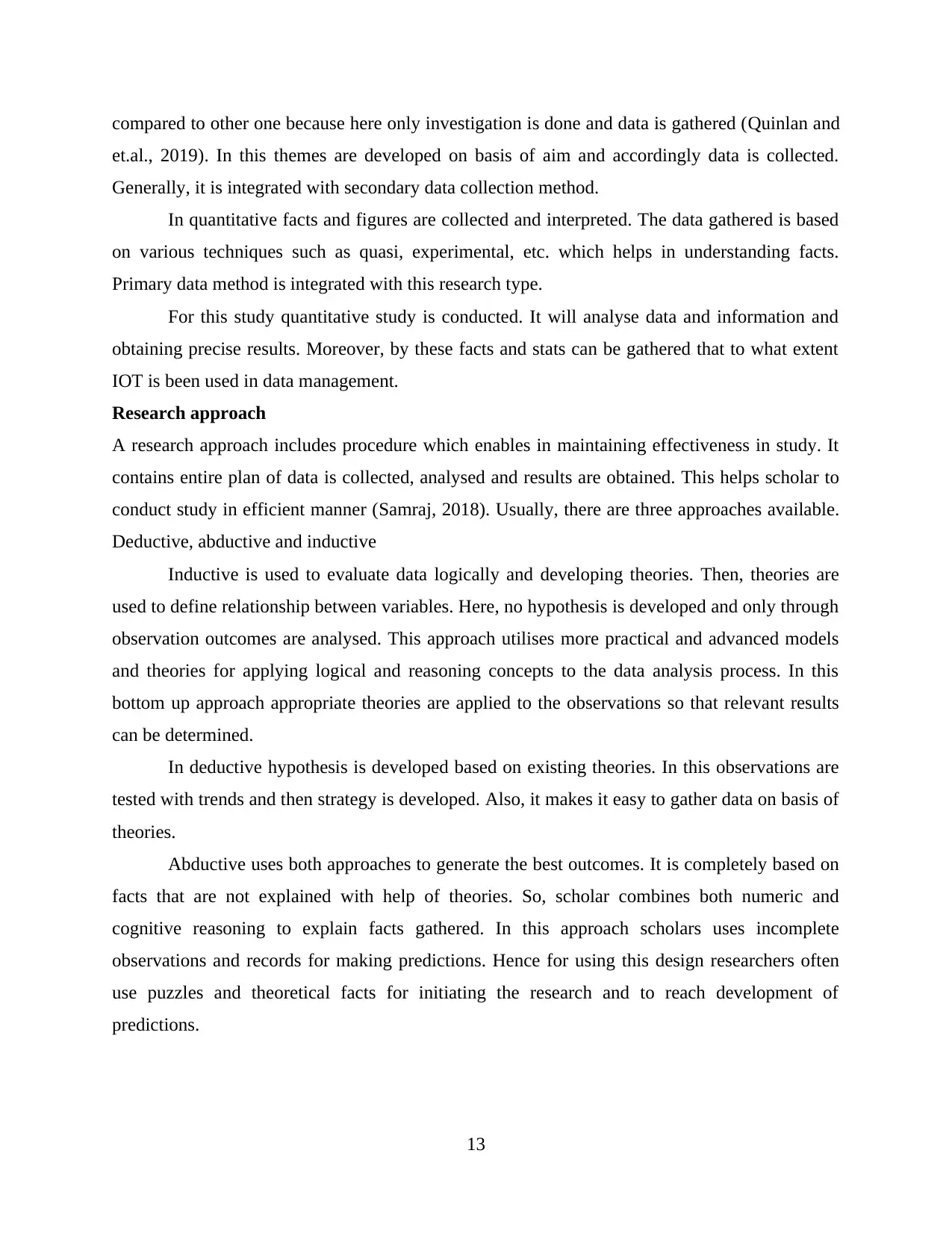
et.al., 2019). In this themes are developed on basis of aim and accordingly data is collected.
Generally, it is integrated with secondary data collection method.
In quantitative facts and figures are collected and interpreted. The data gathered is based
on various techniques such as quasi, experimental, etc. which helps in understanding facts.
Primary data method is integrated with this research type.
For this study quantitative study is conducted. It will analyse data and information and
obtaining precise results. Moreover, by these facts and stats can be gathered that to what extent
IOT is been used in data management.
Research approach
A research approach includes procedure which enables in maintaining effectiveness in study. It
contains entire plan of data is collected, analysed and results are obtained. This helps scholar to
conduct study in efficient manner (Samraj, 2018). Usually, there are three approaches available.
Deductive, abductive and inductive
Inductive is used to evaluate data logically and developing theories. Then, theories are
used to define relationship between variables. Here, no hypothesis is developed and only through
observation outcomes are analysed. This approach utilises more practical and advanced models
and theories for applying logical and reasoning concepts to the data analysis process. In this
bottom up approach appropriate theories are applied to the observations so that relevant results
can be determined.
In deductive hypothesis is developed based on existing theories. In this observations are
tested with trends and then strategy is developed. Also, it makes it easy to gather data on basis of
theories.
Abductive uses both approaches to generate the best outcomes. It is completely based on
facts that are not explained with help of theories. So, scholar combines both numeric and
cognitive reasoning to explain facts gathered. In this approach scholars uses incomplete
observations and records for making predictions. Hence for using this design researchers often
use puzzles and theoretical facts for initiating the research and to reach development of
predictions.
13
Paraphrase This Document
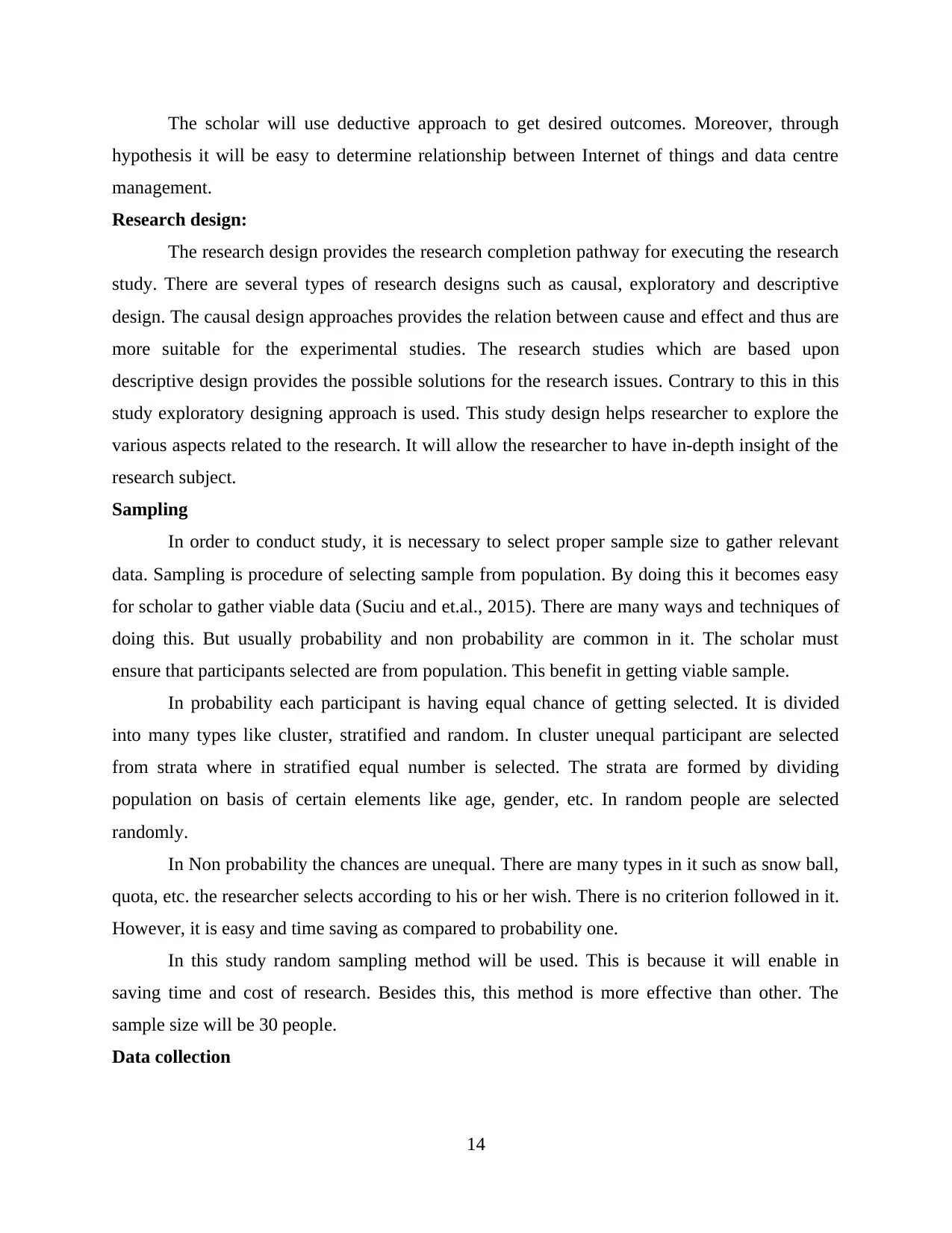
hypothesis it will be easy to determine relationship between Internet of things and data centre
management.
Research design:
The research design provides the research completion pathway for executing the research
study. There are several types of research designs such as causal, exploratory and descriptive
design. The causal design approaches provides the relation between cause and effect and thus are
more suitable for the experimental studies. The research studies which are based upon
descriptive design provides the possible solutions for the research issues. Contrary to this in this
study exploratory designing approach is used. This study design helps researcher to explore the
various aspects related to the research. It will allow the researcher to have in-depth insight of the
research subject.
Sampling
In order to conduct study, it is necessary to select proper sample size to gather relevant
data. Sampling is procedure of selecting sample from population. By doing this it becomes easy
for scholar to gather viable data (Suciu and et.al., 2015). There are many ways and techniques of
doing this. But usually probability and non probability are common in it. The scholar must
ensure that participants selected are from population. This benefit in getting viable sample.
In probability each participant is having equal chance of getting selected. It is divided
into many types like cluster, stratified and random. In cluster unequal participant are selected
from strata where in stratified equal number is selected. The strata are formed by dividing
population on basis of certain elements like age, gender, etc. In random people are selected
randomly.
In Non probability the chances are unequal. There are many types in it such as snow ball,
quota, etc. the researcher selects according to his or her wish. There is no criterion followed in it.
However, it is easy and time saving as compared to probability one.
In this study random sampling method will be used. This is because it will enable in
saving time and cost of research. Besides this, this method is more effective than other. The
sample size will be 30 people.
Data collection
14
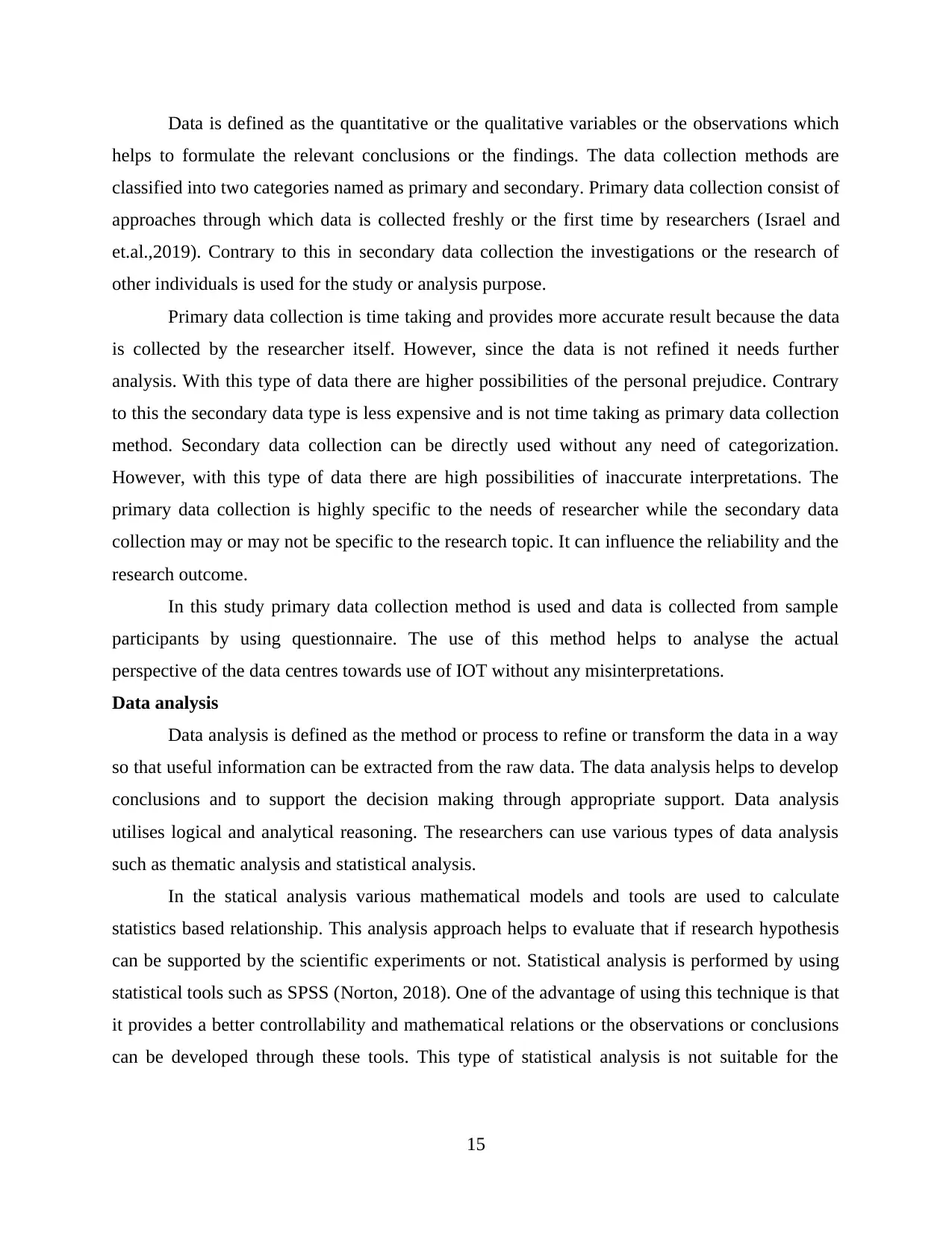
helps to formulate the relevant conclusions or the findings. The data collection methods are
classified into two categories named as primary and secondary. Primary data collection consist of
approaches through which data is collected freshly or the first time by researchers (Israel and
et.al.,2019). Contrary to this in secondary data collection the investigations or the research of
other individuals is used for the study or analysis purpose.
Primary data collection is time taking and provides more accurate result because the data
is collected by the researcher itself. However, since the data is not refined it needs further
analysis. With this type of data there are higher possibilities of the personal prejudice. Contrary
to this the secondary data type is less expensive and is not time taking as primary data collection
method. Secondary data collection can be directly used without any need of categorization.
However, with this type of data there are high possibilities of inaccurate interpretations. The
primary data collection is highly specific to the needs of researcher while the secondary data
collection may or may not be specific to the research topic. It can influence the reliability and the
research outcome.
In this study primary data collection method is used and data is collected from sample
participants by using questionnaire. The use of this method helps to analyse the actual
perspective of the data centres towards use of IOT without any misinterpretations.
Data analysis
Data analysis is defined as the method or process to refine or transform the data in a way
so that useful information can be extracted from the raw data. The data analysis helps to develop
conclusions and to support the decision making through appropriate support. Data analysis
utilises logical and analytical reasoning. The researchers can use various types of data analysis
such as thematic analysis and statistical analysis.
In the statical analysis various mathematical models and tools are used to calculate
statistics based relationship. This analysis approach helps to evaluate that if research hypothesis
can be supported by the scientific experiments or not. Statistical analysis is performed by using
statistical tools such as SPSS (Norton, 2018). One of the advantage of using this technique is that
it provides a better controllability and mathematical relations or the observations or conclusions
can be developed through these tools. This type of statistical analysis is not suitable for the
15
⊘ This is a preview!⊘
Do you want full access?
Subscribe today to unlock all pages.

Trusted by 1+ million students worldwide
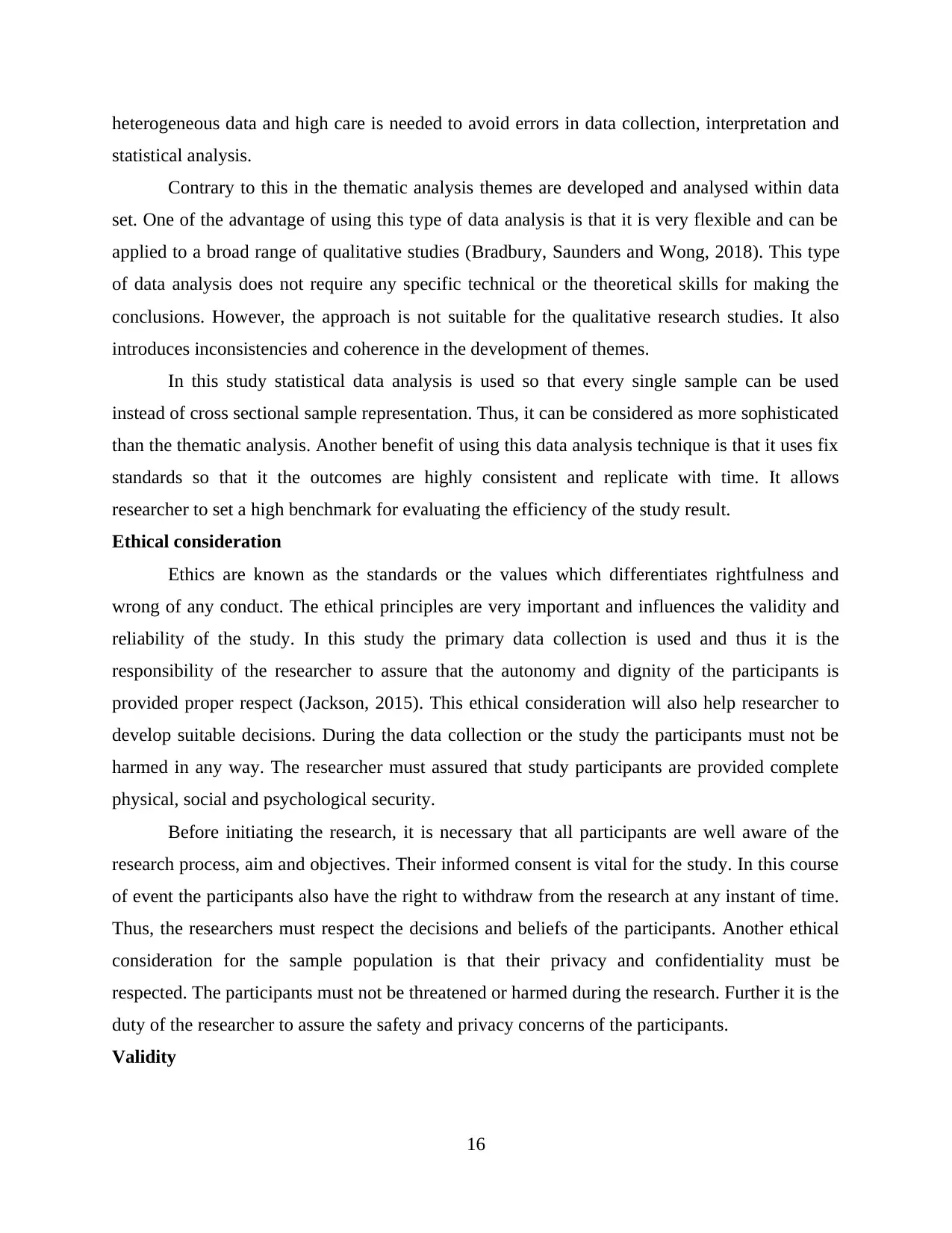
statistical analysis.
Contrary to this in the thematic analysis themes are developed and analysed within data
set. One of the advantage of using this type of data analysis is that it is very flexible and can be
applied to a broad range of qualitative studies (Bradbury, Saunders and Wong, 2018). This type
of data analysis does not require any specific technical or the theoretical skills for making the
conclusions. However, the approach is not suitable for the qualitative research studies. It also
introduces inconsistencies and coherence in the development of themes.
In this study statistical data analysis is used so that every single sample can be used
instead of cross sectional sample representation. Thus, it can be considered as more sophisticated
than the thematic analysis. Another benefit of using this data analysis technique is that it uses fix
standards so that it the outcomes are highly consistent and replicate with time. It allows
researcher to set a high benchmark for evaluating the efficiency of the study result.
Ethical consideration
Ethics are known as the standards or the values which differentiates rightfulness and
wrong of any conduct. The ethical principles are very important and influences the validity and
reliability of the study. In this study the primary data collection is used and thus it is the
responsibility of the researcher to assure that the autonomy and dignity of the participants is
provided proper respect (Jackson, 2015). This ethical consideration will also help researcher to
develop suitable decisions. During the data collection or the study the participants must not be
harmed in any way. The researcher must assured that study participants are provided complete
physical, social and psychological security.
Before initiating the research, it is necessary that all participants are well aware of the
research process, aim and objectives. Their informed consent is vital for the study. In this course
of event the participants also have the right to withdraw from the research at any instant of time.
Thus, the researchers must respect the decisions and beliefs of the participants. Another ethical
consideration for the sample population is that their privacy and confidentiality must be
respected. The participants must not be threatened or harmed during the research. Further it is the
duty of the researcher to assure the safety and privacy concerns of the participants.
Validity
16
Paraphrase This Document

the findings as claimed by the researcher. The research studies are influenced by the several
outcomes. Thus, it is essential that these factors must be controlled and regulated so that validity
of the research can be increased (Bradbury, Saunders and Wong, 2018). There are various types
of validity which must be taken into account in the study. The face validity ensures that the study
methods are related to the high level of subjectivity. The questionnaire design for the study is
highly associated with the subject interest of the participants.
The internal validity of this study is influenced by the internal factors. For instance the
factors such as research design and sampling population can influence the validity of the
research. Contrary to this the external validity of the research is defined as the extent up to which
research findings can be generalised to a large population group (Maar and et.al.,, 2016.). The
factors such as characteristics of population, data collection methods, research environment and
time frame influences the external validity of the research.
17
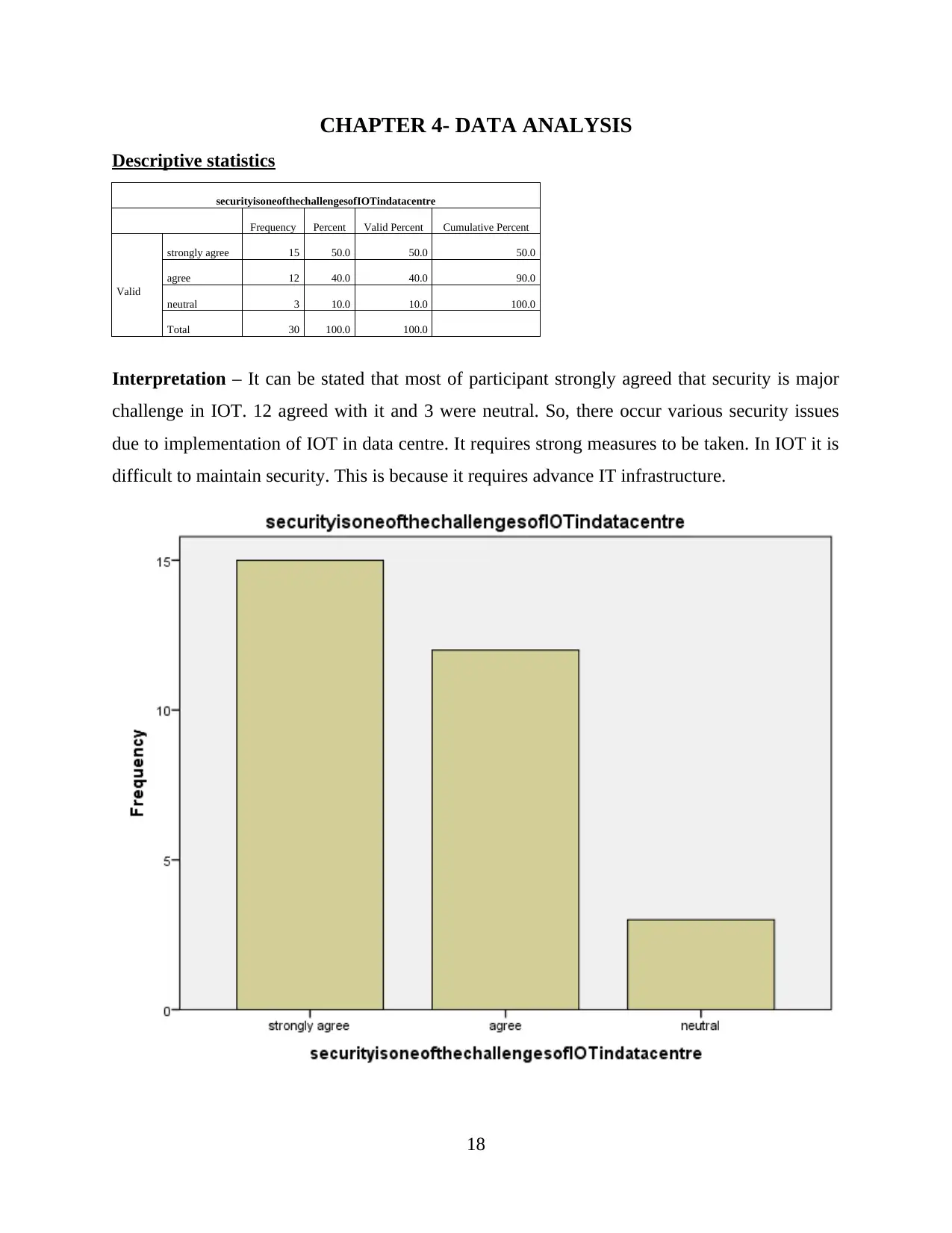
Descriptive statistics
securityisoneofthechallengesofIOTindatacentre
Frequency Percent Valid Percent Cumulative Percent
Valid
strongly agree 15 50.0 50.0 50.0
agree 12 40.0 40.0 90.0
neutral 3 10.0 10.0 100.0
Total 30 100.0 100.0
Interpretation – It can be stated that most of participant strongly agreed that security is major
challenge in IOT. 12 agreed with it and 3 were neutral. So, there occur various security issues
due to implementation of IOT in data centre. It requires strong measures to be taken. In IOT it is
difficult to maintain security. This is because it requires advance IT infrastructure.
18
⊘ This is a preview!⊘
Do you want full access?
Subscribe today to unlock all pages.

Trusted by 1+ million students worldwide
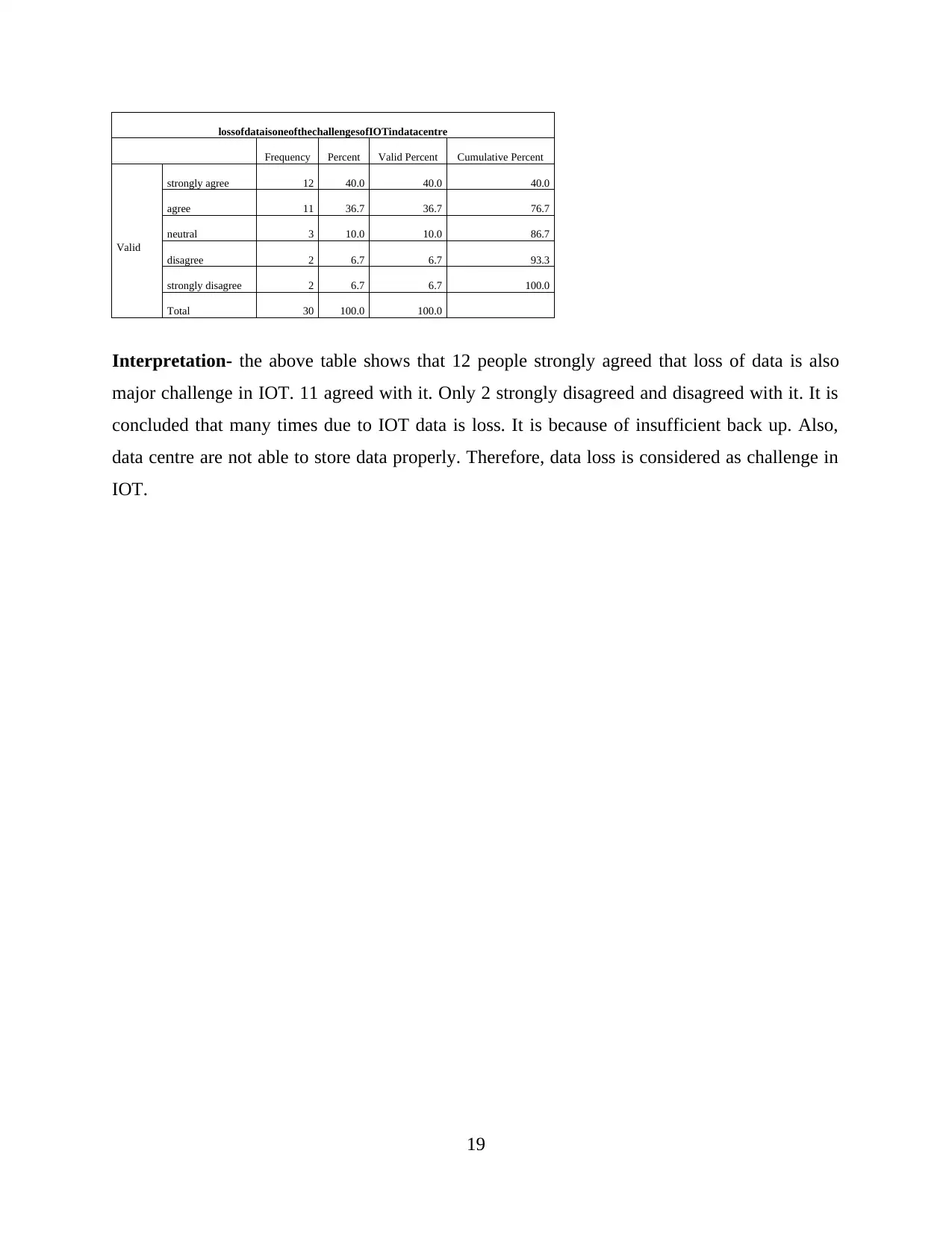
Frequency Percent Valid Percent Cumulative Percent
Valid
strongly agree 12 40.0 40.0 40.0
agree 11 36.7 36.7 76.7
neutral 3 10.0 10.0 86.7
disagree 2 6.7 6.7 93.3
strongly disagree 2 6.7 6.7 100.0
Total 30 100.0 100.0
Interpretation- the above table shows that 12 people strongly agreed that loss of data is also
major challenge in IOT. 11 agreed with it. Only 2 strongly disagreed and disagreed with it. It is
concluded that many times due to IOT data is loss. It is because of insufficient back up. Also,
data centre are not able to store data properly. Therefore, data loss is considered as challenge in
IOT.
19
Paraphrase This Document
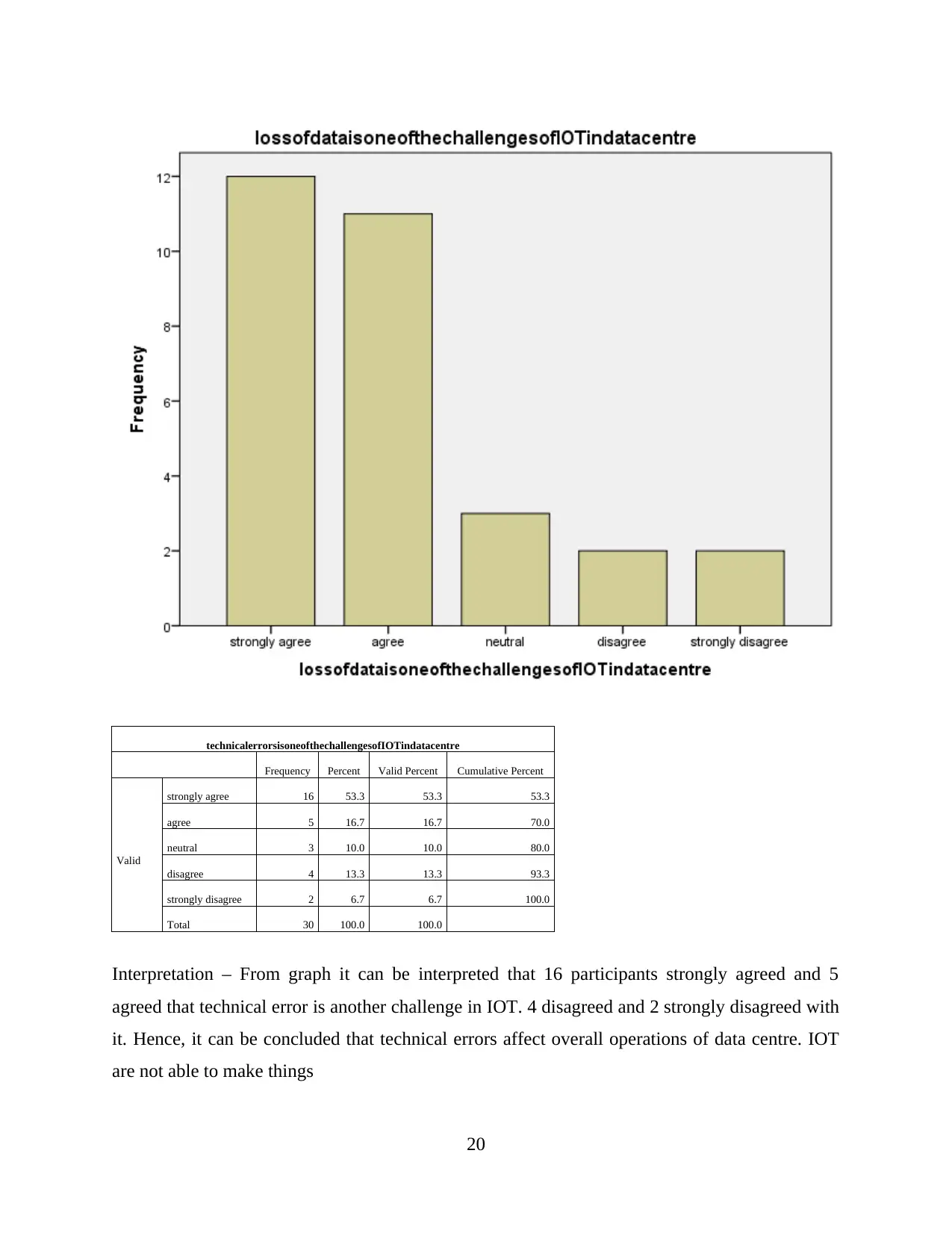
Frequency Percent Valid Percent Cumulative Percent
Valid
strongly agree 16 53.3 53.3 53.3
agree 5 16.7 16.7 70.0
neutral 3 10.0 10.0 80.0
disagree 4 13.3 13.3 93.3
strongly disagree 2 6.7 6.7 100.0
Total 30 100.0 100.0
Interpretation – From graph it can be interpreted that 16 participants strongly agreed and 5
agreed that technical error is another challenge in IOT. 4 disagreed and 2 strongly disagreed with
it. Hence, it can be concluded that technical errors affect overall operations of data centre. IOT
are not able to make things
20
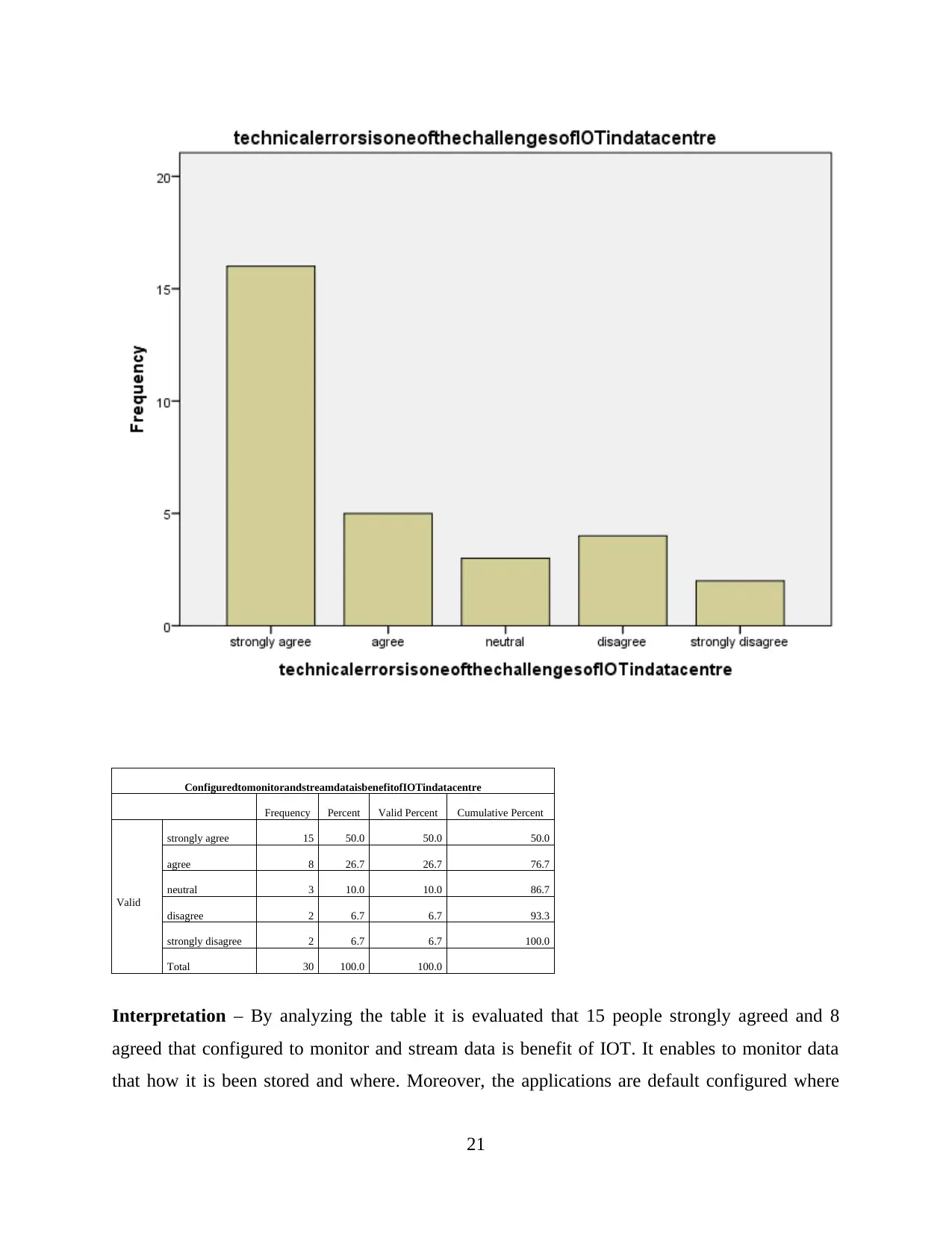
Frequency Percent Valid Percent Cumulative Percent
Valid
strongly agree 15 50.0 50.0 50.0
agree 8 26.7 26.7 76.7
neutral 3 10.0 10.0 86.7
disagree 2 6.7 6.7 93.3
strongly disagree 2 6.7 6.7 100.0
Total 30 100.0 100.0
Interpretation – By analyzing the table it is evaluated that 15 people strongly agreed and 8
agreed that configured to monitor and stream data is benefit of IOT. It enables to monitor data
that how it is been stored and where. Moreover, the applications are default configured where
21
⊘ This is a preview!⊘
Do you want full access?
Subscribe today to unlock all pages.

Trusted by 1+ million students worldwide
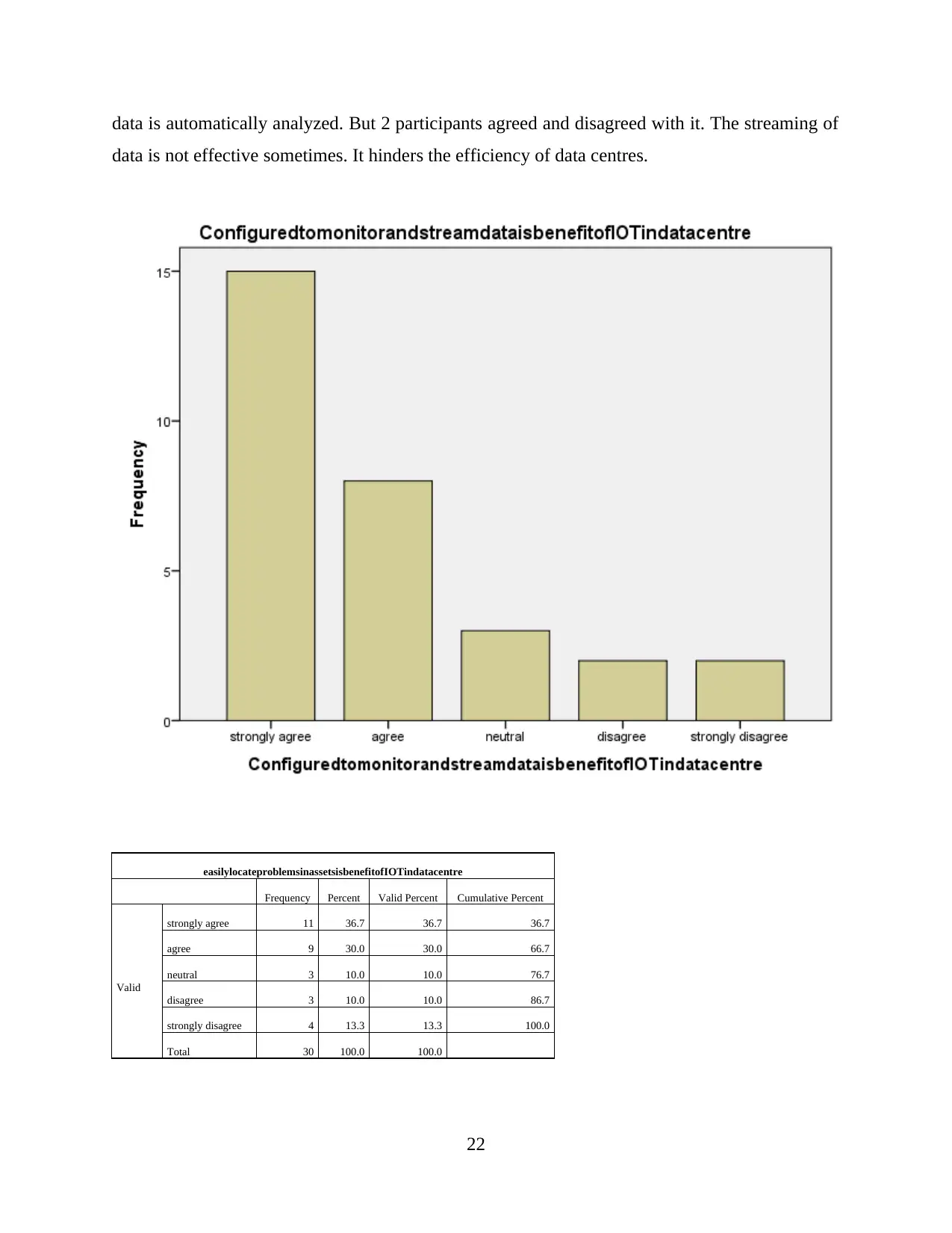
data is not effective sometimes. It hinders the efficiency of data centres.
easilylocateproblemsinassetsisbenefitofIOTindatacentre
Frequency Percent Valid Percent Cumulative Percent
Valid
strongly agree 11 36.7 36.7 36.7
agree 9 30.0 30.0 66.7
neutral 3 10.0 10.0 76.7
disagree 3 10.0 10.0 86.7
strongly disagree 4 13.3 13.3 100.0
Total 30 100.0 100.0
22
Paraphrase This Document

benefit of easily locating of problems by IOT in data center. Whereas 3 remain neutral, 3
disagreed and 3 strongly disagreed with it. In data center, IOT identify problems in software and
system. It is configured in such a way that issues are automatically detected. Also, the use of IOT
improves efficiency of data centre. The systems are integrated to a centralized server. Thus,
issues are easily detected and solved.
improvetrackingofassetsisbenefitofIOTindatacentre
Frequency Percent Valid Percent Cumulative Percent
Valid
strongly agree 18 60.0 60.0 60.0
agree 9 30.0 30.0 90.0
neutral 3 10.0 10.0 100.0
Total 30 100.0 100.0
23
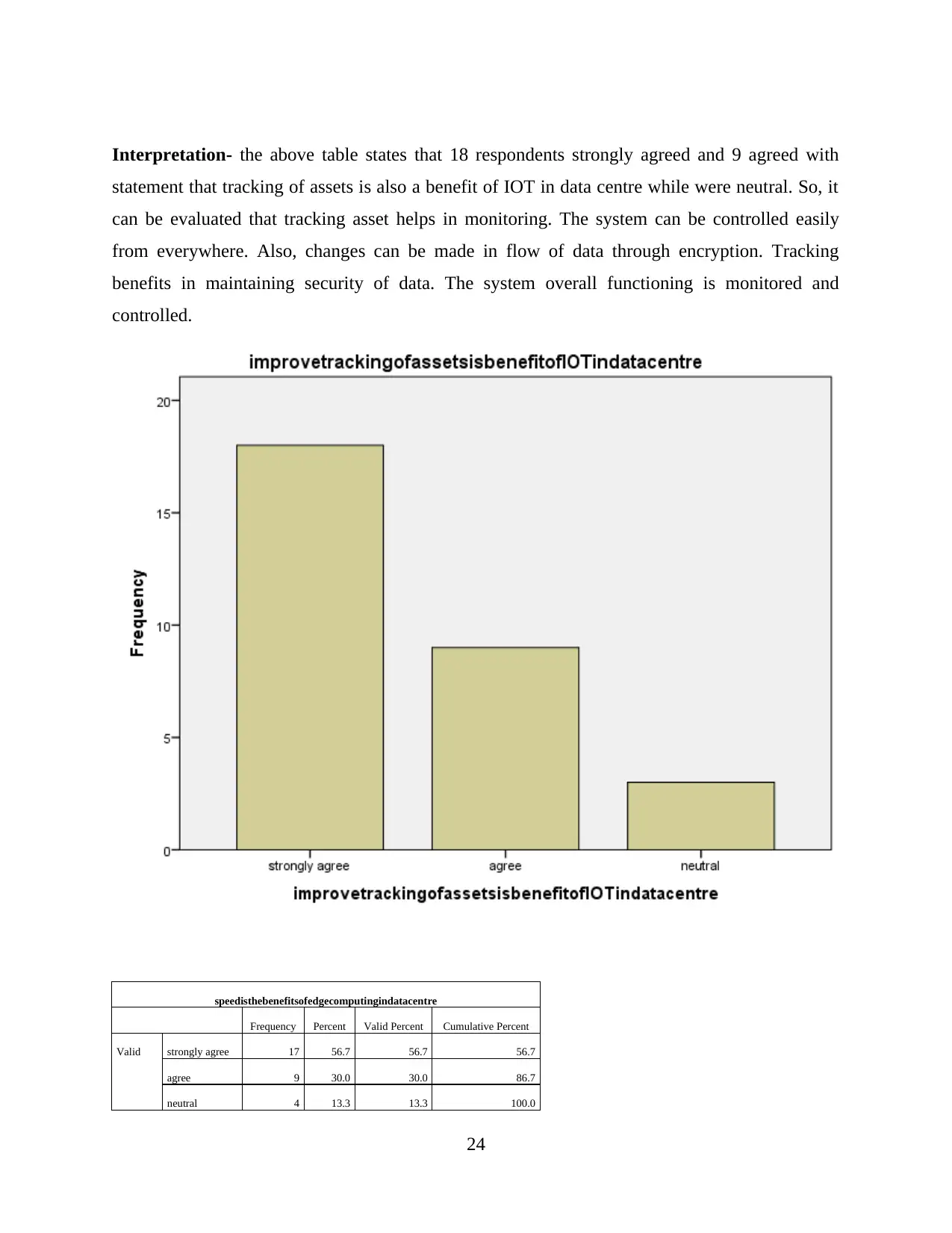
statement that tracking of assets is also a benefit of IOT in data centre while were neutral. So, it
can be evaluated that tracking asset helps in monitoring. The system can be controlled easily
from everywhere. Also, changes can be made in flow of data through encryption. Tracking
benefits in maintaining security of data. The system overall functioning is monitored and
controlled.
speedisthebenefitsofedgecomputingindatacentre
Frequency Percent Valid Percent Cumulative Percent
Valid strongly agree 17 56.7 56.7 56.7
agree 9 30.0 30.0 86.7
neutral 4 13.3 13.3 100.0
24
⊘ This is a preview!⊘
Do you want full access?
Subscribe today to unlock all pages.

Trusted by 1+ million students worldwide
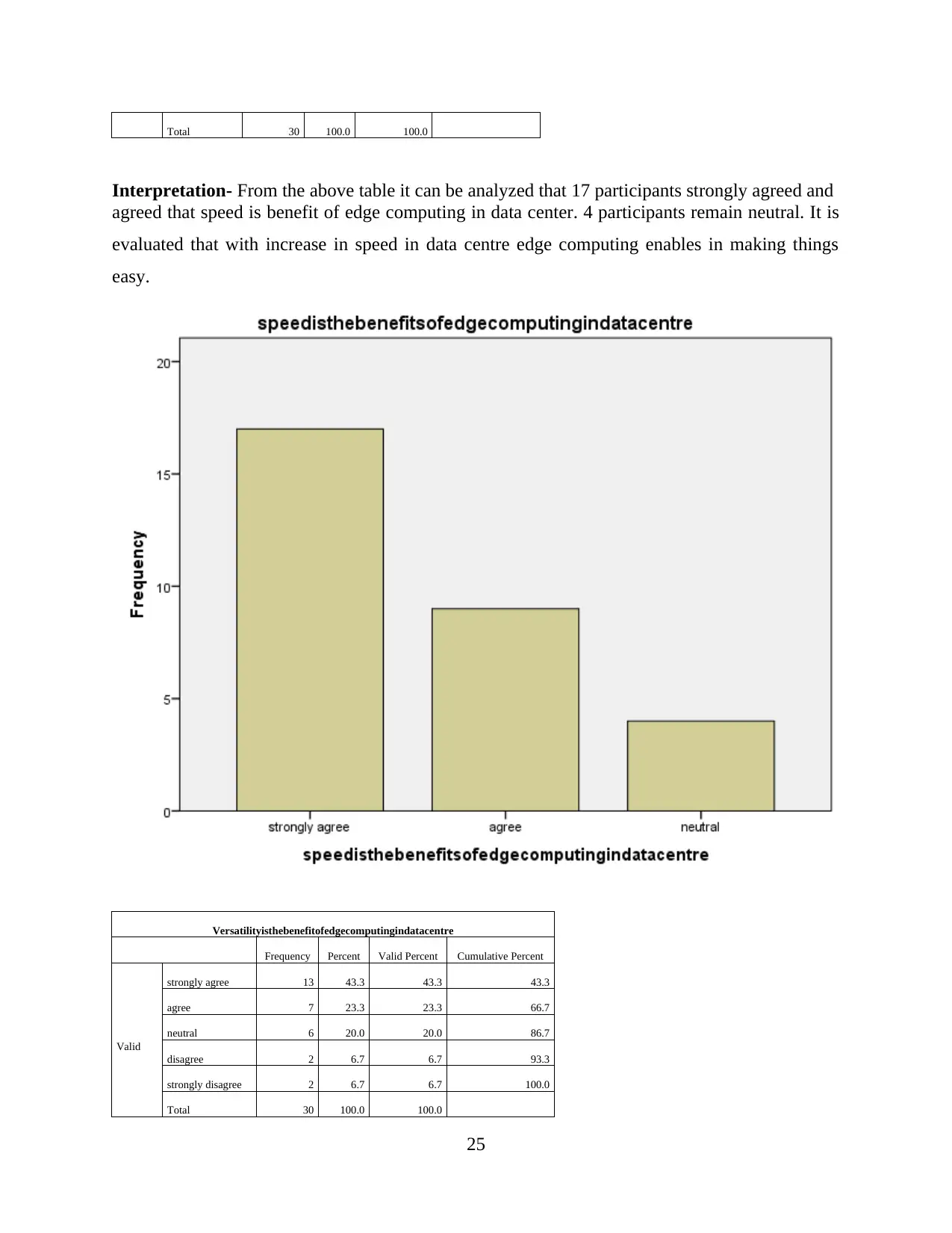
Interpretation- From the above table it can be analyzed that 17 participants strongly agreed and
agreed that speed is benefit of edge computing in data center. 4 participants remain neutral. It is
evaluated that with increase in speed in data centre edge computing enables in making things
easy.
Versatilityisthebenefitofedgecomputingindatacentre
Frequency Percent Valid Percent Cumulative Percent
Valid
strongly agree 13 43.3 43.3 43.3
agree 7 23.3 23.3 66.7
neutral 6 20.0 20.0 86.7
disagree 2 6.7 6.7 93.3
strongly disagree 2 6.7 6.7 100.0
Total 30 100.0 100.0
25
Paraphrase This Document
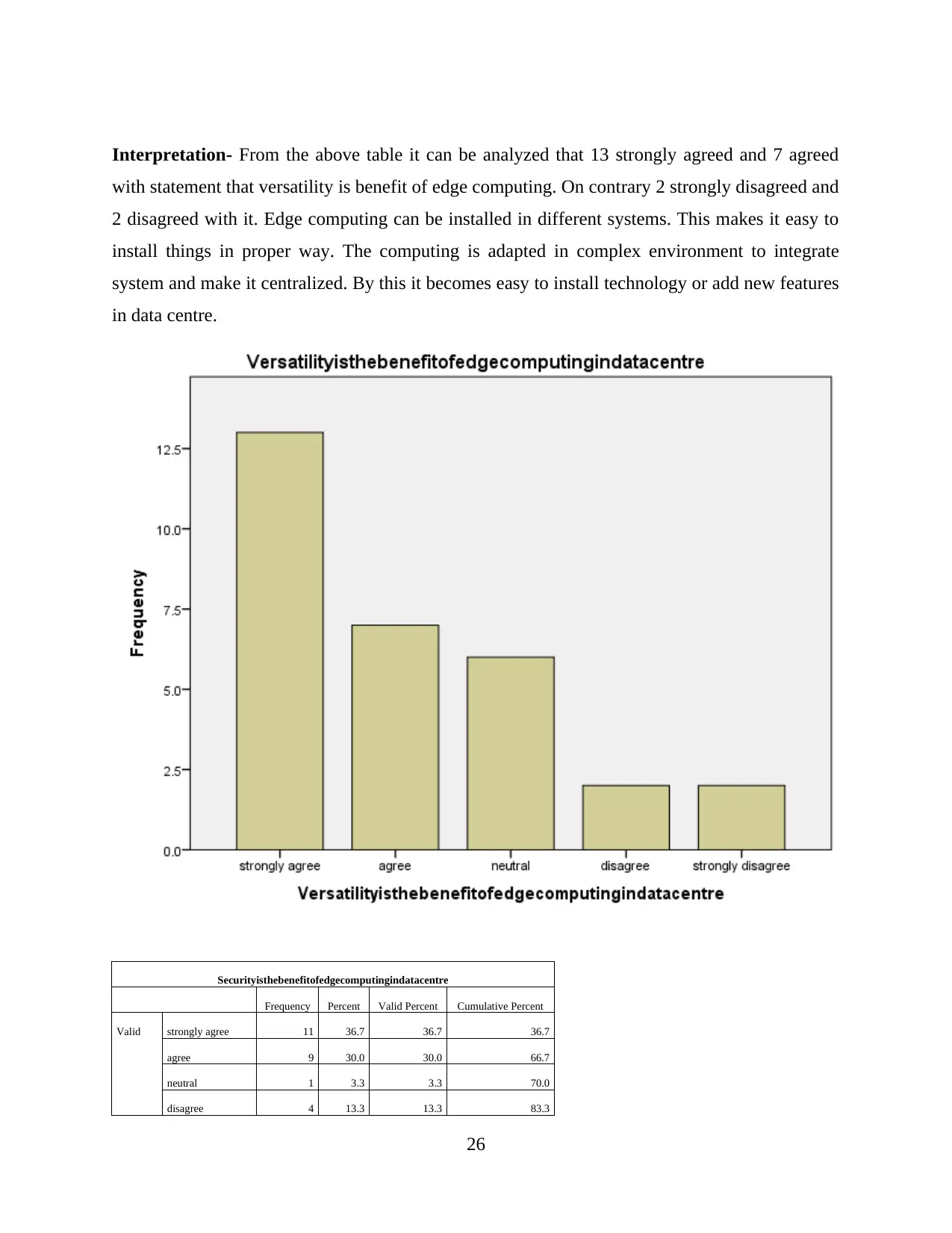
with statement that versatility is benefit of edge computing. On contrary 2 strongly disagreed and
2 disagreed with it. Edge computing can be installed in different systems. This makes it easy to
install things in proper way. The computing is adapted in complex environment to integrate
system and make it centralized. By this it becomes easy to install technology or add new features
in data centre.
Securityisthebenefitofedgecomputingindatacentre
Frequency Percent Valid Percent Cumulative Percent
Valid strongly agree 11 36.7 36.7 36.7
agree 9 30.0 30.0 66.7
neutral 1 3.3 3.3 70.0
disagree 4 13.3 13.3 83.3
26
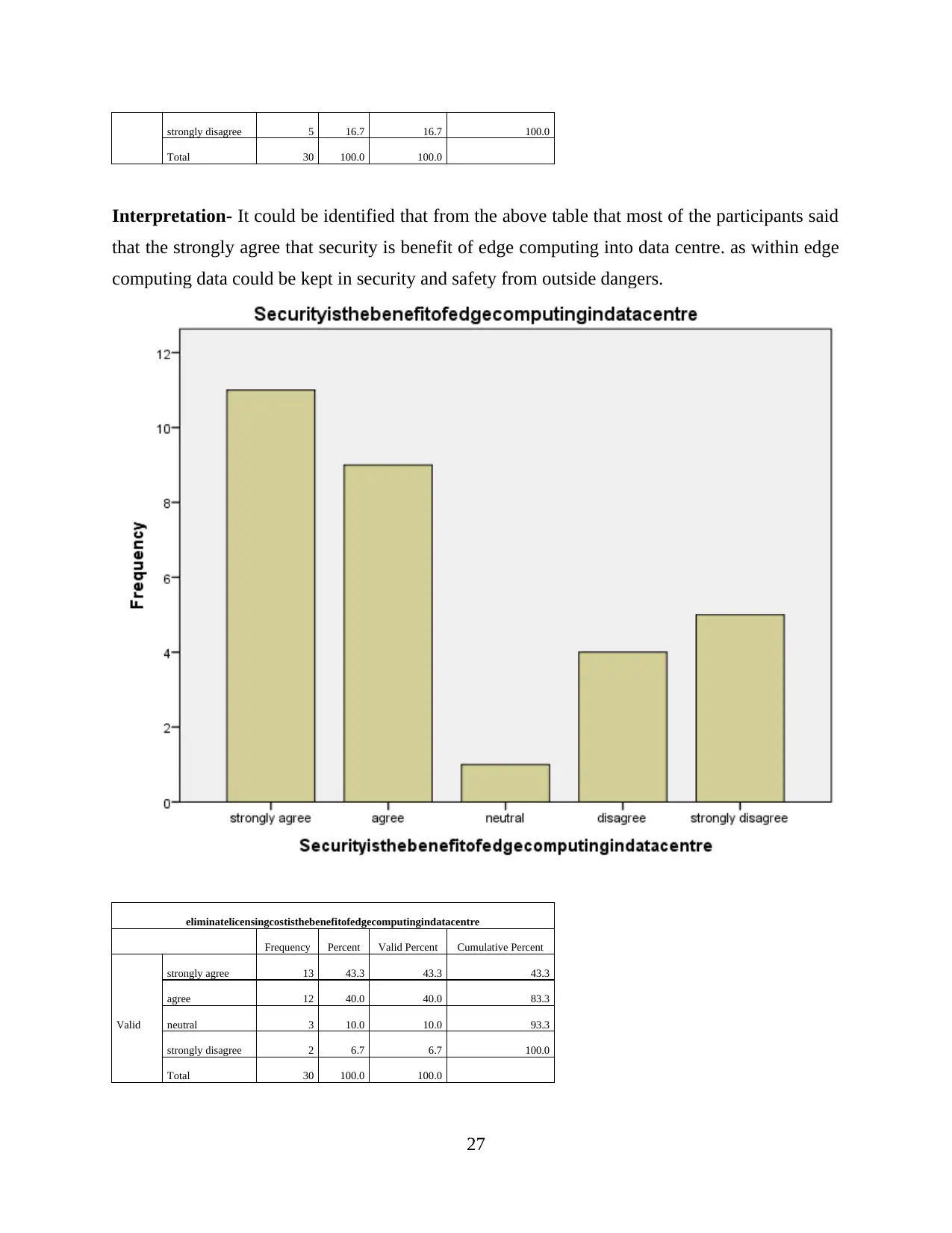
Total 30 100.0 100.0
Interpretation- It could be identified that from the above table that most of the participants said
that the strongly agree that security is benefit of edge computing into data centre. as within edge
computing data could be kept in security and safety from outside dangers.
eliminatelicensingcostisthebenefitofedgecomputingindatacentre
Frequency Percent Valid Percent Cumulative Percent
Valid
strongly agree 13 43.3 43.3 43.3
agree 12 40.0 40.0 83.3
neutral 3 10.0 10.0 93.3
strongly disagree 2 6.7 6.7 100.0
Total 30 100.0 100.0
27
⊘ This is a preview!⊘
Do you want full access?
Subscribe today to unlock all pages.

Trusted by 1+ million students worldwide

that eliminating licensing cost is very much benefit of edge computing within data center. as cost
of licensing will be decreased and reduced so that it is moving faster and is safer as well
Regression
Model Variables Entered Variables Removed Method
1
lossofdataisoneofthech
allengesofIOTindatace
ntreb
. Enter
28
Paraphrase This Document
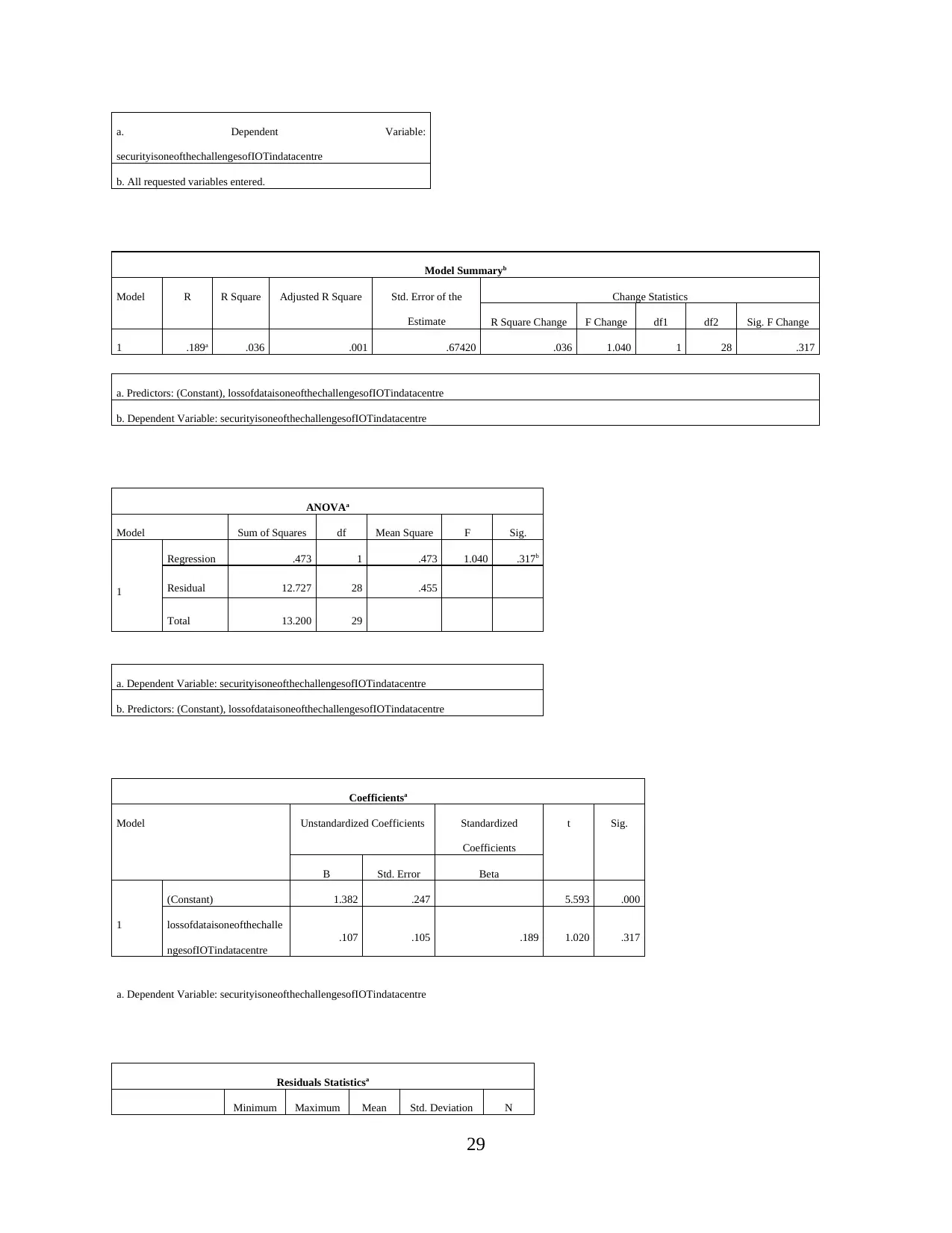
securityisoneofthechallengesofIOTindatacentre
b. All requested variables entered.
Model Summaryb
Model R R Square Adjusted R Square Std. Error of the
Estimate
Change Statistics
R Square Change F Change df1 df2 Sig. F Change
1 .189a .036 .001 .67420 .036 1.040 1 28 .317
a. Predictors: (Constant), lossofdataisoneofthechallengesofIOTindatacentre
b. Dependent Variable: securityisoneofthechallengesofIOTindatacentre
ANOVAa
Model Sum of Squares df Mean Square F Sig.
1
Regression .473 1 .473 1.040 .317b
Residual 12.727 28 .455
Total 13.200 29
a. Dependent Variable: securityisoneofthechallengesofIOTindatacentre
b. Predictors: (Constant), lossofdataisoneofthechallengesofIOTindatacentre
Coefficientsa
Model Unstandardized Coefficients Standardized
Coefficients
t Sig.
B Std. Error Beta
1
(Constant) 1.382 .247 5.593 .000
lossofdataisoneofthechalle
ngesofIOTindatacentre
.107 .105 .189 1.020 .317
a. Dependent Variable: securityisoneofthechallengesofIOTindatacentre
Residuals Statisticsa
Minimum Maximum Mean Std. Deviation N
29
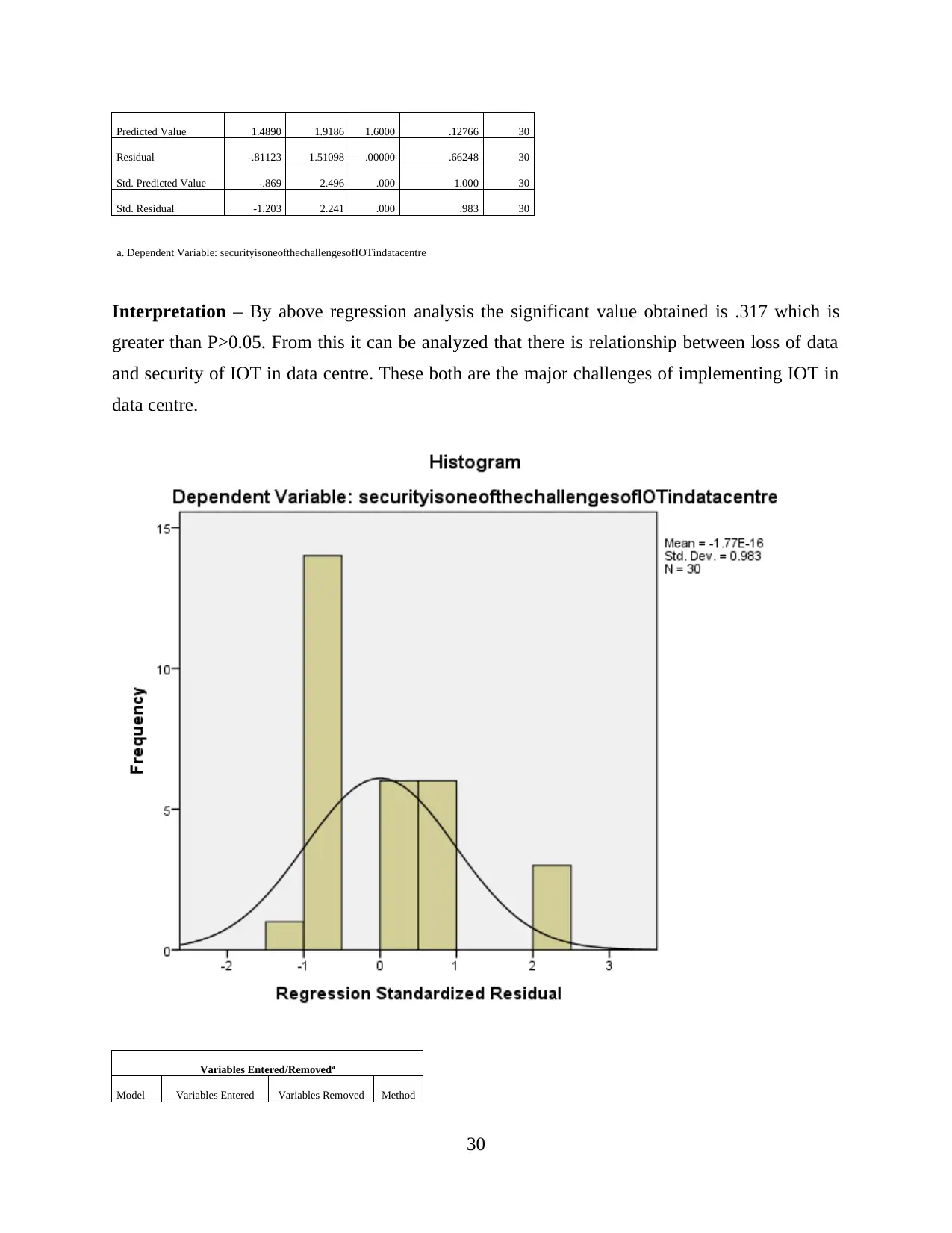
Residual -.81123 1.51098 .00000 .66248 30
Std. Predicted Value -.869 2.496 .000 1.000 30
Std. Residual -1.203 2.241 .000 .983 30
a. Dependent Variable: securityisoneofthechallengesofIOTindatacentre
Interpretation – By above regression analysis the significant value obtained is .317 which is
greater than P>0.05. From this it can be analyzed that there is relationship between loss of data
and security of IOT in data centre. These both are the major challenges of implementing IOT in
data centre.
Variables Entered/Removeda
Model Variables Entered Variables Removed Method
30
⊘ This is a preview!⊘
Do you want full access?
Subscribe today to unlock all pages.

Trusted by 1+ million students worldwide
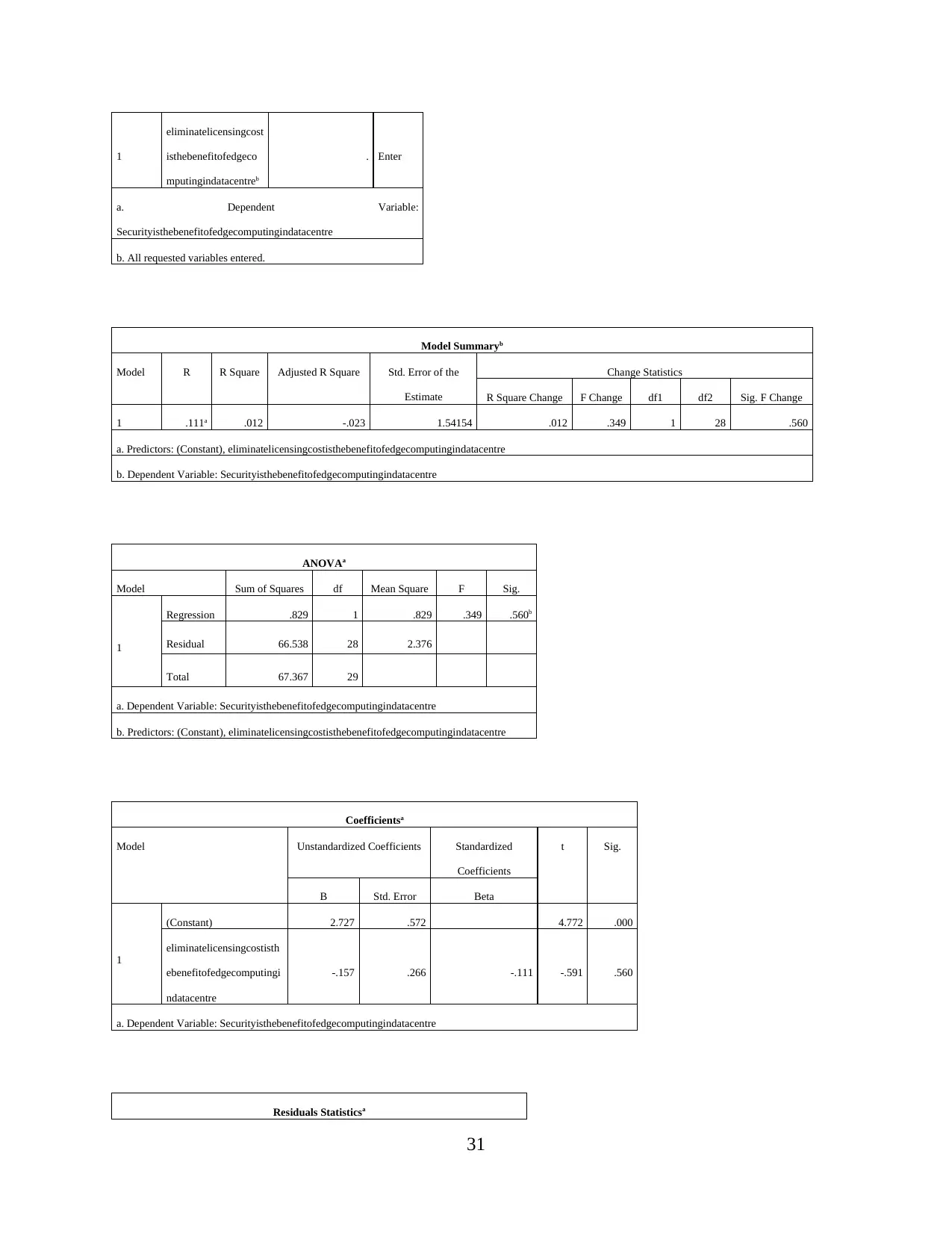
eliminatelicensingcost
isthebenefitofedgeco
mputingindatacentreb
. Enter
a. Dependent Variable:
Securityisthebenefitofedgecomputingindatacentre
b. All requested variables entered.
Model Summaryb
Model R R Square Adjusted R Square Std. Error of the
Estimate
Change Statistics
R Square Change F Change df1 df2 Sig. F Change
1 .111a .012 -.023 1.54154 .012 .349 1 28 .560
a. Predictors: (Constant), eliminatelicensingcostisthebenefitofedgecomputingindatacentre
b. Dependent Variable: Securityisthebenefitofedgecomputingindatacentre
ANOVAa
Model Sum of Squares df Mean Square F Sig.
1
Regression .829 1 .829 .349 .560b
Residual 66.538 28 2.376
Total 67.367 29
a. Dependent Variable: Securityisthebenefitofedgecomputingindatacentre
b. Predictors: (Constant), eliminatelicensingcostisthebenefitofedgecomputingindatacentre
Coefficientsa
Model Unstandardized Coefficients Standardized
Coefficients
t Sig.
B Std. Error Beta
1
(Constant) 2.727 .572 4.772 .000
eliminatelicensingcostisth
ebenefitofedgecomputingi
ndatacentre
-.157 .266 -.111 -.591 .560
a. Dependent Variable: Securityisthebenefitofedgecomputingindatacentre
Residuals Statisticsa
31
Paraphrase This Document
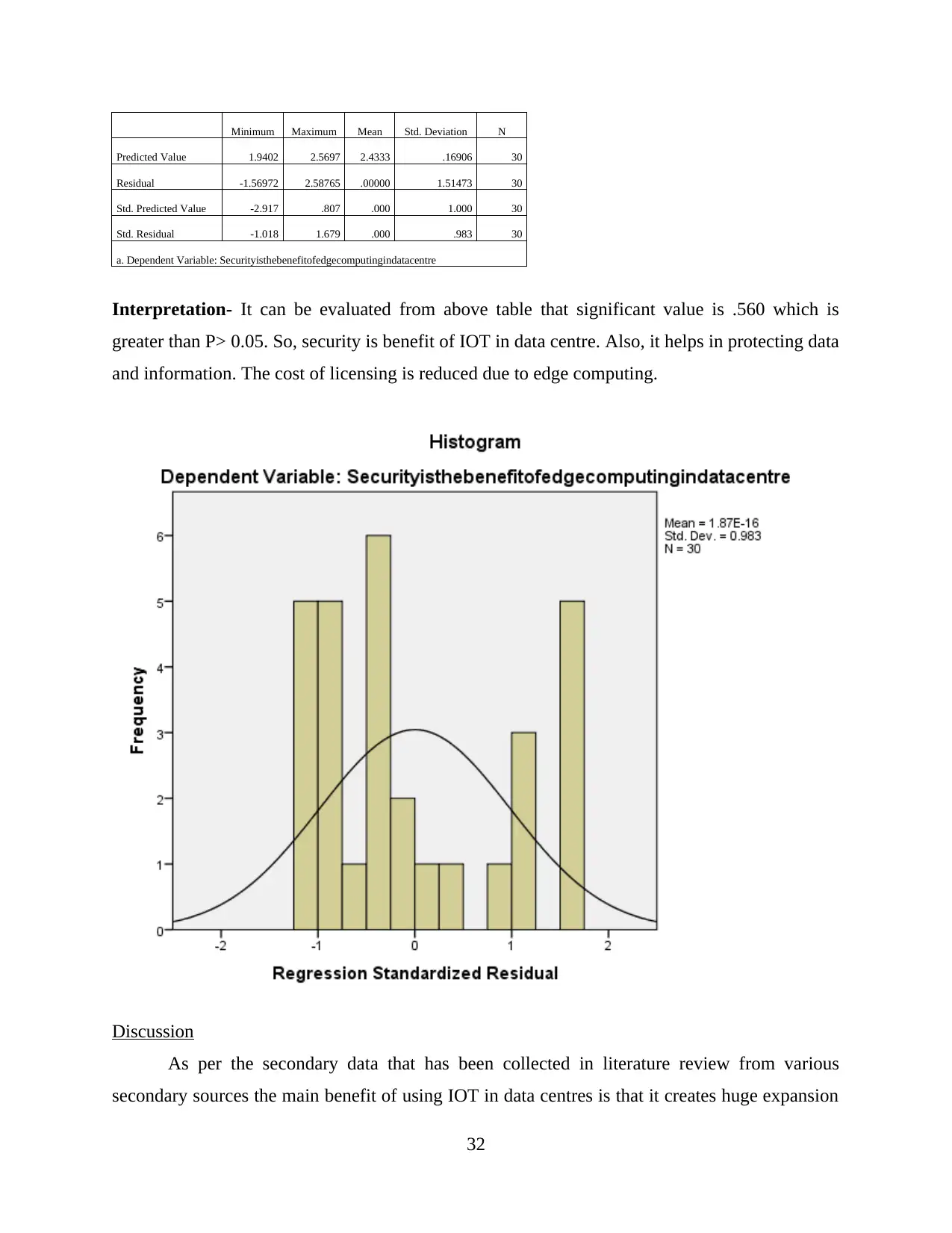
Predicted Value 1.9402 2.5697 2.4333 .16906 30
Residual -1.56972 2.58765 .00000 1.51473 30
Std. Predicted Value -2.917 .807 .000 1.000 30
Std. Residual -1.018 1.679 .000 .983 30
a. Dependent Variable: Securityisthebenefitofedgecomputingindatacentre
Interpretation- It can be evaluated from above table that significant value is .560 which is
greater than P> 0.05. So, security is benefit of IOT in data centre. Also, it helps in protecting data
and information. The cost of licensing is reduced due to edge computing.
Discussion
As per the secondary data that has been collected in literature review from various
secondary sources the main benefit of using IOT in data centres is that it creates huge expansion
32
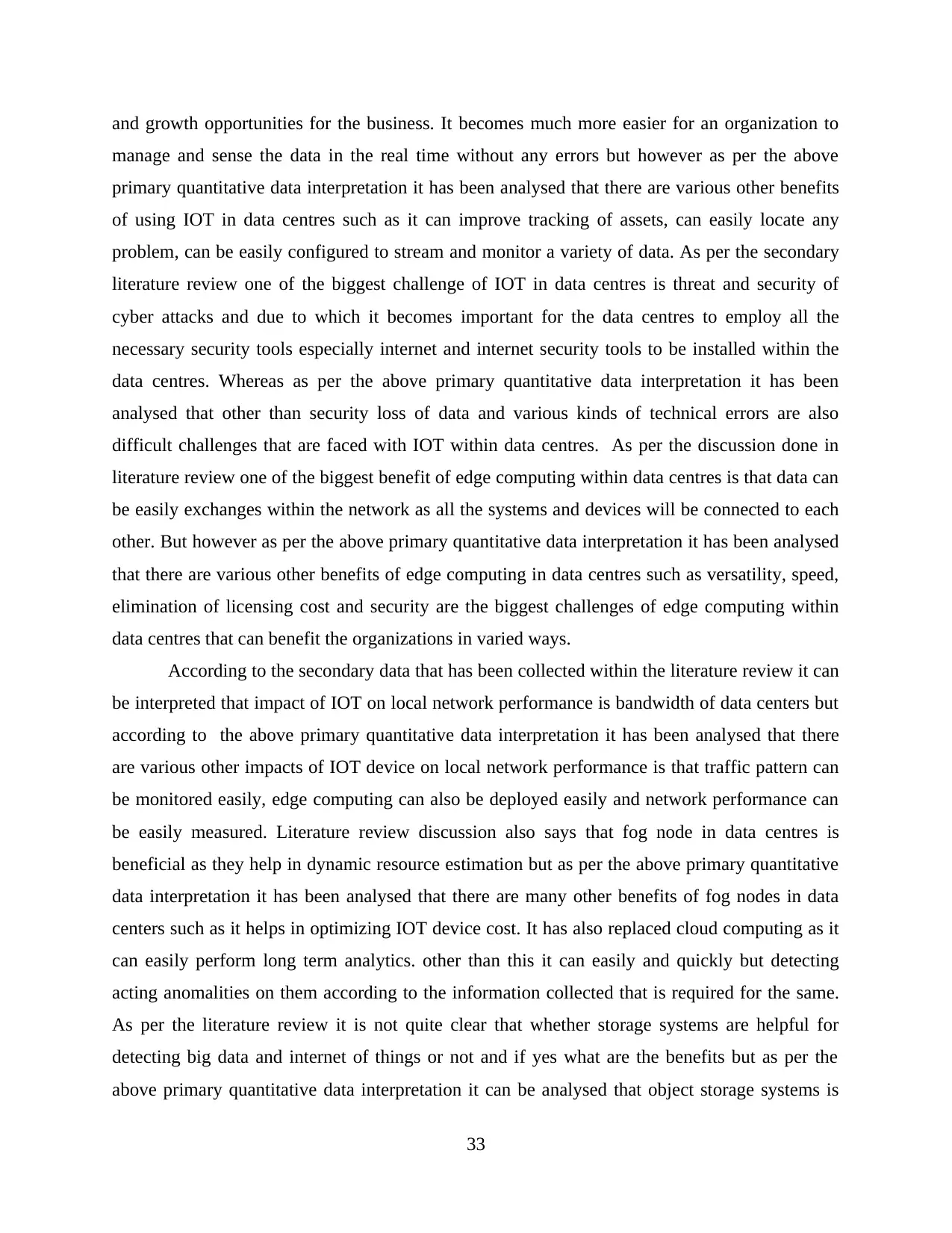
manage and sense the data in the real time without any errors but however as per the above
primary quantitative data interpretation it has been analysed that there are various other benefits
of using IOT in data centres such as it can improve tracking of assets, can easily locate any
problem, can be easily configured to stream and monitor a variety of data. As per the secondary
literature review one of the biggest challenge of IOT in data centres is threat and security of
cyber attacks and due to which it becomes important for the data centres to employ all the
necessary security tools especially internet and internet security tools to be installed within the
data centres. Whereas as per the above primary quantitative data interpretation it has been
analysed that other than security loss of data and various kinds of technical errors are also
difficult challenges that are faced with IOT within data centres. As per the discussion done in
literature review one of the biggest benefit of edge computing within data centres is that data can
be easily exchanges within the network as all the systems and devices will be connected to each
other. But however as per the above primary quantitative data interpretation it has been analysed
that there are various other benefits of edge computing in data centres such as versatility, speed,
elimination of licensing cost and security are the biggest challenges of edge computing within
data centres that can benefit the organizations in varied ways.
According to the secondary data that has been collected within the literature review it can
be interpreted that impact of IOT on local network performance is bandwidth of data centers but
according to the above primary quantitative data interpretation it has been analysed that there
are various other impacts of IOT device on local network performance is that traffic pattern can
be monitored easily, edge computing can also be deployed easily and network performance can
be easily measured. Literature review discussion also says that fog node in data centres is
beneficial as they help in dynamic resource estimation but as per the above primary quantitative
data interpretation it has been analysed that there are many other benefits of fog nodes in data
centers such as it helps in optimizing IOT device cost. It has also replaced cloud computing as it
can easily perform long term analytics. other than this it can easily and quickly but detecting
acting anomalities on them according to the information collected that is required for the same.
As per the literature review it is not quite clear that whether storage systems are helpful for
detecting big data and internet of things or not and if yes what are the benefits but as per the
above primary quantitative data interpretation it can be analysed that object storage systems is
33
⊘ This is a preview!⊘
Do you want full access?
Subscribe today to unlock all pages.

Trusted by 1+ million students worldwide

network latency, it stores data very close to edge and in the form of hierarchical tree structure
and other than this it also supports Hdoop.
According to the secondary data discussion it can be analysed that the main focus area for data
center security is to insure secure data transmission while as per the above primary quantitative
data interpretation it has been analysed that the main focus area for data centre security is to
restrict access, increase physical security of data centre, increase network security as well as
server security for the data centres. However when it comes to impact of IOT on data centres
answer of both secondary data and primary data is same which says that its main impact is that it
inbounds data flow and network requirements, optimizing storage, it is quite cost effective and
impacts on other systems as well as it also impacts data centre location. As per both secondary
and primary data there is no additional cost required for implementation of internet of things in
data centre. Other than this IOT solutions also make a great difference in data centre like system
monitoring is dome easily, provides analytical platform and helps in data collection.
34
Paraphrase This Document
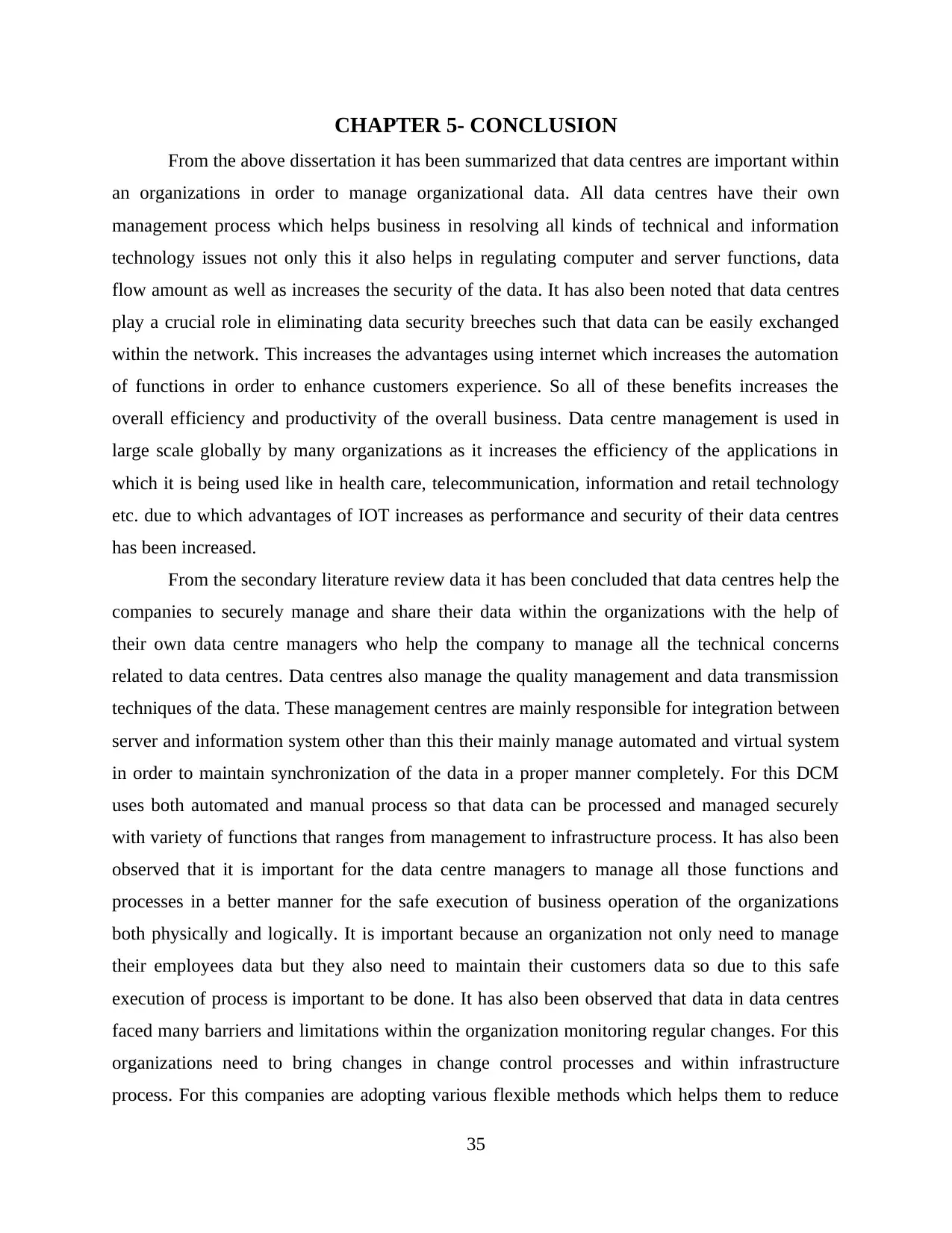
From the above dissertation it has been summarized that data centres are important within
an organizations in order to manage organizational data. All data centres have their own
management process which helps business in resolving all kinds of technical and information
technology issues not only this it also helps in regulating computer and server functions, data
flow amount as well as increases the security of the data. It has also been noted that data centres
play a crucial role in eliminating data security breeches such that data can be easily exchanged
within the network. This increases the advantages using internet which increases the automation
of functions in order to enhance customers experience. So all of these benefits increases the
overall efficiency and productivity of the overall business. Data centre management is used in
large scale globally by many organizations as it increases the efficiency of the applications in
which it is being used like in health care, telecommunication, information and retail technology
etc. due to which advantages of IOT increases as performance and security of their data centres
has been increased.
From the secondary literature review data it has been concluded that data centres help the
companies to securely manage and share their data within the organizations with the help of
their own data centre managers who help the company to manage all the technical concerns
related to data centres. Data centres also manage the quality management and data transmission
techniques of the data. These management centres are mainly responsible for integration between
server and information system other than this their mainly manage automated and virtual system
in order to maintain synchronization of the data in a proper manner completely. For this DCM
uses both automated and manual process so that data can be processed and managed securely
with variety of functions that ranges from management to infrastructure process. It has also been
observed that it is important for the data centre managers to manage all those functions and
processes in a better manner for the safe execution of business operation of the organizations
both physically and logically. It is important because an organization not only need to manage
their employees data but they also need to maintain their customers data so due to this safe
execution of process is important to be done. It has also been observed that data in data centres
faced many barriers and limitations within the organization monitoring regular changes. For this
organizations need to bring changes in change control processes and within infrastructure
process. For this companies are adopting various flexible methods which helps them to reduce
35

that these DCM processes should be performed in such a way that compliance and backup issues
can be resolved easily. If it is not done in such way then it may lead the organization to fail
within a certain task or might increase management threat, disturb the timing schedule and
various other.
From the study it has been observed that lack of effective DCM techniques can increases
the complexity of the organizations business and due to which it can become tough for the
managers to manage all the processes and functions which can further result in increased
complexity of data or in loss of data. Other than this DCM are also responsible for managing
data storage capacity as it has been one of the major for the managers who are involved in data
management. As per the literature review it has been observed that it is important for the DCM
managers to review data transmission services on regular basis for the improved quality as DCM
are mainly associated with safety, security of the data and data systems. Another way though
which data centres security can be increased has also been observed which ca be done by using
cloud services as it can not only increase the security of the data but also helps in increasing the
overall revenue of the organization. Cloud services are beneficial despite of the doubts and
controversies associated with it. Above secondary study concludes that DCM are crucial part of
the business as compared to before as it monitors and organises all the essential information
required to run a business such that it can run for a longer period. Many organizations have
centralized their operations, equipment as well as all the other data that are important for the
organization. This helps the company to manage all the technical problems associated with all
the technologies that are being used within the business. This also benefits the company by
securing their essential information for others. For this many companies heir skilled employees
who have desired knowledge and skills who can manage data centres efficiently.
As per the secondary research it has been summarized that there are various kinds of
technologies such as embedded systems, machine learning’s etc. that help the organization to
exchange and share information in the real time quickly within a given instance of time. These
technologies are designed in such a way that it can be used by both business, customers as well
as for service providers. Data centres are one of the best technology that helps the organization in
creating huge opportunities such that they can expand their business and focus on all the other
growth opportunities which can also help them in making their services and products automated
36
⊘ This is a preview!⊘
Do you want full access?
Subscribe today to unlock all pages.

Trusted by 1+ million students worldwide
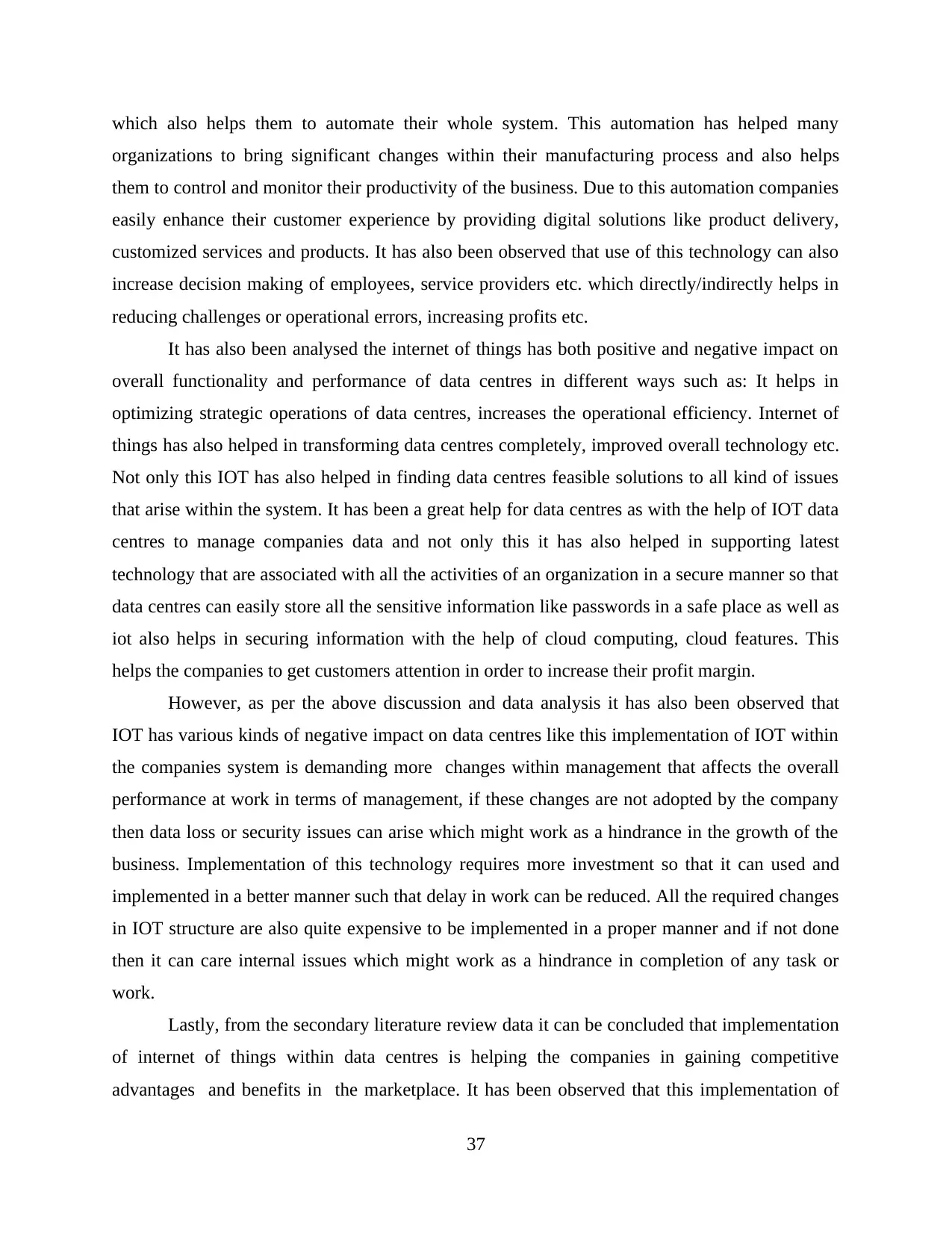
organizations to bring significant changes within their manufacturing process and also helps
them to control and monitor their productivity of the business. Due to this automation companies
easily enhance their customer experience by providing digital solutions like product delivery,
customized services and products. It has also been observed that use of this technology can also
increase decision making of employees, service providers etc. which directly/indirectly helps in
reducing challenges or operational errors, increasing profits etc.
It has also been analysed the internet of things has both positive and negative impact on
overall functionality and performance of data centres in different ways such as: It helps in
optimizing strategic operations of data centres, increases the operational efficiency. Internet of
things has also helped in transforming data centres completely, improved overall technology etc.
Not only this IOT has also helped in finding data centres feasible solutions to all kind of issues
that arise within the system. It has been a great help for data centres as with the help of IOT data
centres to manage companies data and not only this it has also helped in supporting latest
technology that are associated with all the activities of an organization in a secure manner so that
data centres can easily store all the sensitive information like passwords in a safe place as well as
iot also helps in securing information with the help of cloud computing, cloud features. This
helps the companies to get customers attention in order to increase their profit margin.
However, as per the above discussion and data analysis it has also been observed that
IOT has various kinds of negative impact on data centres like this implementation of IOT within
the companies system is demanding more changes within management that affects the overall
performance at work in terms of management, if these changes are not adopted by the company
then data loss or security issues can arise which might work as a hindrance in the growth of the
business. Implementation of this technology requires more investment so that it can used and
implemented in a better manner such that delay in work can be reduced. All the required changes
in IOT structure are also quite expensive to be implemented in a proper manner and if not done
then it can care internal issues which might work as a hindrance in completion of any task or
work.
Lastly, from the secondary literature review data it can be concluded that implementation
of internet of things within data centres is helping the companies in gaining competitive
advantages and benefits in the marketplace. It has been observed that this implementation of
37
Paraphrase This Document
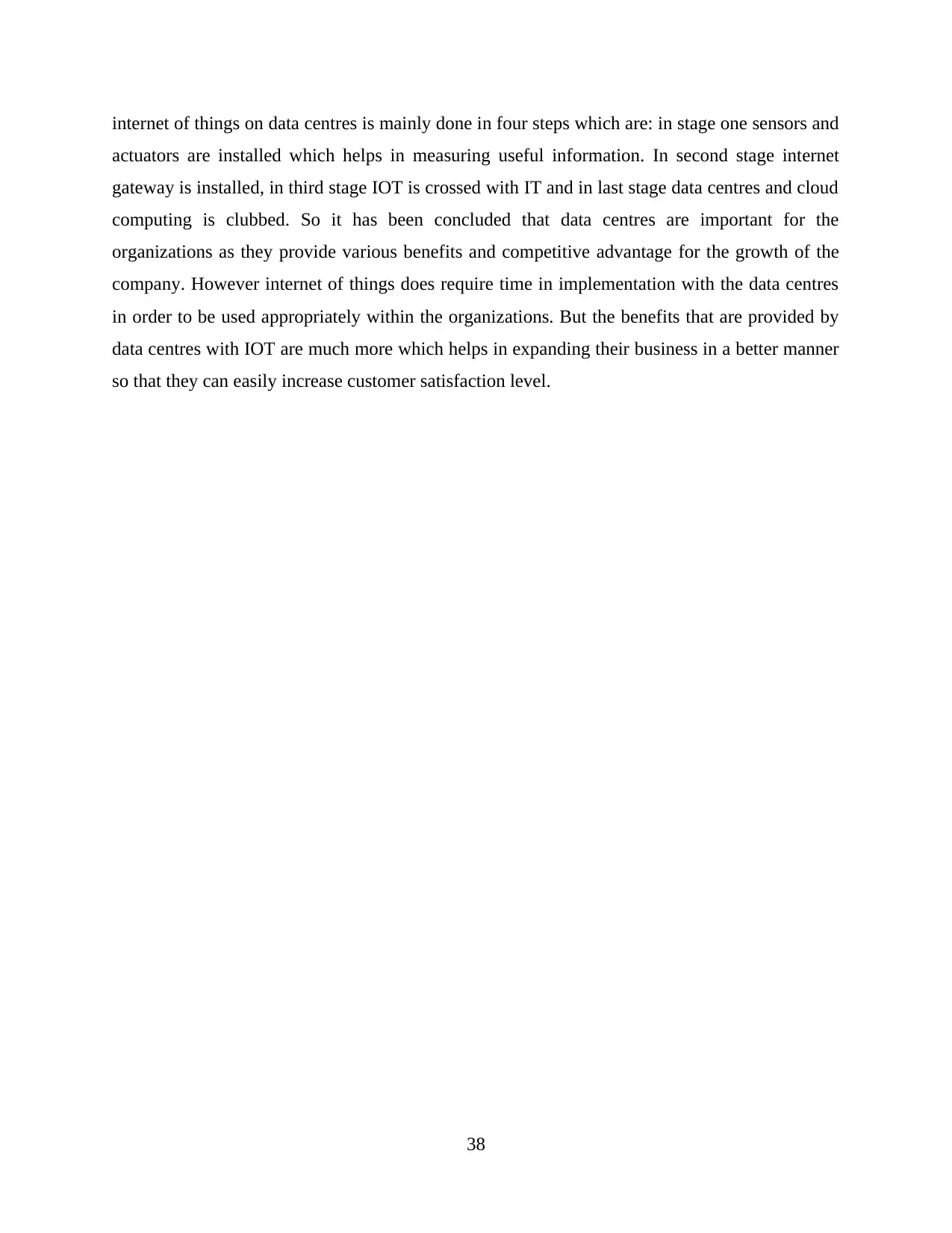
actuators are installed which helps in measuring useful information. In second stage internet
gateway is installed, in third stage IOT is crossed with IT and in last stage data centres and cloud
computing is clubbed. So it has been concluded that data centres are important for the
organizations as they provide various benefits and competitive advantage for the growth of the
company. However internet of things does require time in implementation with the data centres
in order to be used appropriately within the organizations. But the benefits that are provided by
data centres with IOT are much more which helps in expanding their business in a better manner
so that they can easily increase customer satisfaction level.
38

Books and Journals
Aazam, M. and Huh, E.N., 2015, March. Fog computing micro datacenter based dynamic
resource estimation and pricing model for IoT. In 2015 IEEE 29th International
Conference on Advanced Information Networking and Applications (pp. 687-694). IEEE.
Abbasi, M.A. and et.al., 2017. Addressing the future data management challenges in iot: A
proposed framework. International Journal of Advanced Computer Science and
Applications. 8(5). pp.197-207.
Akhbar, F. and et.al., 2016. Outlook on moving of computing services towards the data
sources. International Journal of Information Management. 36(4). pp.645-652.
Ben-Daya, M., Hassini, E. and Bahroun, Z., 2017. Internet of things and supply chain
management: a literature review. International Journal of Production Research, pp.1-24.
Bradlow, H., 2015. The impact of emerging technologies in the workforce of the
future. Australia’s future workforce. pp.38-47.
Brown, H.S., 2016. After the data breach: Managing the crisis and mitigating the impact. Journal
of business continuity & emergency planning. 9(4). pp.317-328.
de Assuncao, M.D., da Silva Veith, A. and Buyya, R., 2018. Distributed data stream processing
and edge computing: A survey on resource elasticity and future directions. Journal of
Network and Computer Applications. 103. pp.1-17.
Ekbia, H. and et.al., 2015. Big data, bigger dilemmas: A critical review. Journal of the
Association for Information Science and Technology. 66(8). pp.1523-1545.
Elhoseny, M. and et.al., 2018. A hybrid model of internet of things and cloud computing to
manage big data in health services applications. Future generation computer systems. 86.
pp.1383-1394.
Fernandez, F. and Pallis, G.C., 2014. Opportunities and challenges of the Internet of Things for
healthcare: Systems engineering perspective. In 2014 4th International Conference on
Wireless Mobile Communication and Healthcare-Transforming Healthcare Through
Innovations in Mobile and Wireless Technologies (MOBIHEALTH) (pp. 263-266). IEEE.
Jaiswal, S. and Gupta, D., 2017. Security requirements for internet of things (iot).
In Proceedings of International Conference on Communication and Networks (pp. 419-
427). Springer, Singapore.
Jayaraman, P.P. and et.al., 2017. Analytics‐as‐a‐service in a multi‐cloud environment through
semantically‐enabled hierarchical data processing. Software: Practice and
Experience. 47(8). pp.1139-1156.
Kay, R. and Alder, J., 2017. Coastal planning and management. CRC Press.
Levy, M. and Hallstrom, J.O., 2017. A reliable non-invasive approach to data center monitoring
and management. Advances in Science, Technology and Engineering Systems
Journal. 2(3). pp.1577-1584.
Morley, J., Widdicks, K. and Hazas, M., 2018. Digitalisation, energy and data demand: The
impact of Internet traffic on overall and peak electricity consumption. Energy Research &
Social Science. 38. pp.128-137.
O’Donovan, P. and et.al., 2015. An industrial big data pipeline for data-driven analytics
maintenance applications in large-scale smart manufacturing facilities. Journal of Big
Data. 2 (1). p.25.
39
⊘ This is a preview!⊘
Do you want full access?
Subscribe today to unlock all pages.

Trusted by 1+ million students worldwide
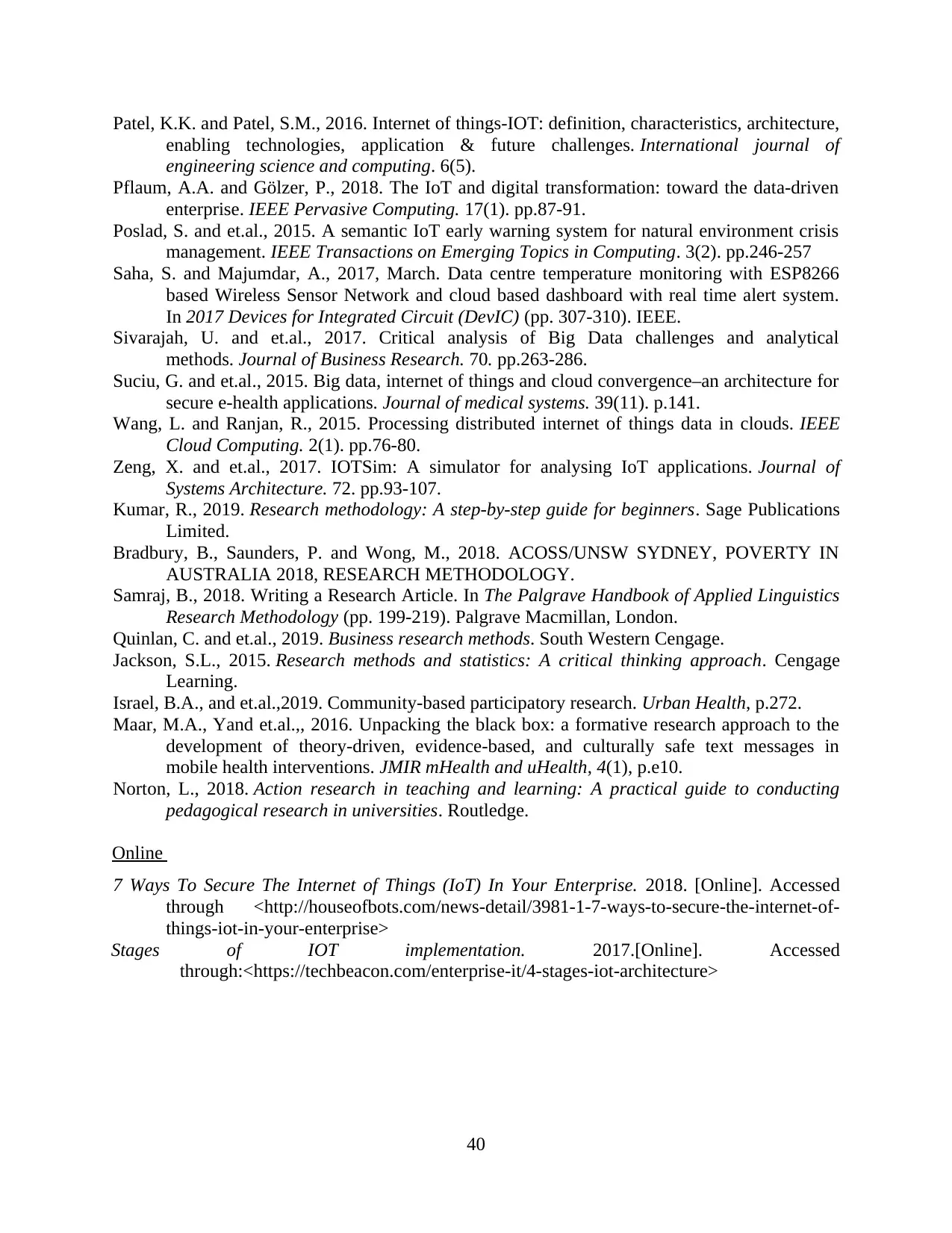
enabling technologies, application & future challenges. International journal of
engineering science and computing. 6(5).
Pflaum, A.A. and Gölzer, P., 2018. The IoT and digital transformation: toward the data-driven
enterprise. IEEE Pervasive Computing. 17(1). pp.87-91.
Poslad, S. and et.al., 2015. A semantic IoT early warning system for natural environment crisis
management. IEEE Transactions on Emerging Topics in Computing. 3(2). pp.246-257
Saha, S. and Majumdar, A., 2017, March. Data centre temperature monitoring with ESP8266
based Wireless Sensor Network and cloud based dashboard with real time alert system.
In 2017 Devices for Integrated Circuit (DevIC) (pp. 307-310). IEEE.
Sivarajah, U. and et.al., 2017. Critical analysis of Big Data challenges and analytical
methods. Journal of Business Research. 70. pp.263-286.
Suciu, G. and et.al., 2015. Big data, internet of things and cloud convergence–an architecture for
secure e-health applications. Journal of medical systems. 39(11). p.141.
Wang, L. and Ranjan, R., 2015. Processing distributed internet of things data in clouds. IEEE
Cloud Computing. 2(1). pp.76-80.
Zeng, X. and et.al., 2017. IOTSim: A simulator for analysing IoT applications. Journal of
Systems Architecture. 72. pp.93-107.
Kumar, R., 2019. Research methodology: A step-by-step guide for beginners. Sage Publications
Limited.
Bradbury, B., Saunders, P. and Wong, M., 2018. ACOSS/UNSW SYDNEY, POVERTY IN
AUSTRALIA 2018, RESEARCH METHODOLOGY.
Samraj, B., 2018. Writing a Research Article. In The Palgrave Handbook of Applied Linguistics
Research Methodology (pp. 199-219). Palgrave Macmillan, London.
Quinlan, C. and et.al., 2019. Business research methods. South Western Cengage.
Jackson, S.L., 2015. Research methods and statistics: A critical thinking approach. Cengage
Learning.
Israel, B.A., and et.al.,2019. Community-based participatory research. Urban Health, p.272.
Maar, M.A., Yand et.al.,, 2016. Unpacking the black box: a formative research approach to the
development of theory-driven, evidence-based, and culturally safe text messages in
mobile health interventions. JMIR mHealth and uHealth, 4(1), p.e10.
Norton, L., 2018. Action research in teaching and learning: A practical guide to conducting
pedagogical research in universities. Routledge.
Online
7 Ways To Secure The Internet of Things (IoT) In Your Enterprise. 2018. [Online]. Accessed
through <http://houseofbots.com/news-detail/3981-1-7-ways-to-secure-the-internet-of-
things-iot-in-your-enterprise>
Stages of IOT implementation. 2017.[Online]. Accessed
through:<https://techbeacon.com/enterprise-it/4-stages-iot-architecture>
40
Related Documents
Your All-in-One AI-Powered Toolkit for Academic Success.
+13062052269
info@desklib.com
Available 24*7 on WhatsApp / Email
![[object Object]](/_next/static/media/star-bottom.7253800d.svg)
© 2024 | Zucol Services PVT LTD | All rights reserved.





